SCHEME OF WORK FOR JSS 1 FIRST TERM
WEEKS TOPICS
1. Orientation
- Learning about science
- Meaning and definition of science.
- Branches of science; science related occupations
- Reasons why we study science
2. Scientific Methods
- Observation, experimentation, recording etc.
- Some skills a beginner should develop (students to use concrete objects to develop their skills in observation, guesses and sorting things out) etc.
3. Family Health (Cleanliness)
- Personal cleanliness
- Meaning Methods
- Advantages/disadvantages
4. Family Health (Nutrition)
- Food and adequate diet;
- Type/composition
- Adequate diet
5. Environmental conservation and safety (Maintaining Balance)
- Source of earth energy
- Water cycle
6. Carbon and Nitrogen Cycles
- Conservation of energy, water and wild life
7. Environmental Conservation and Safety (Sanitation)
- Types of human activities e.g. farming, sewage/refuse disposal, construction, transportation, industrialization etc.
8. Biodegradable and non-biodegradable materials.
- The compost
- Benefits of environmental sanitation.
9. Disease vectors
- Types of disease vectors.
- Life cycle of the mosquito and other vectors.
10. Control measures: water drainage, insecticides, oil
spreading/spraying
- Transmission of malaria, river blindness and sleeping sickness.
11. Prevention: Clean water
- Water borne disease; cholera, diarrhea, typhoid.
- Sources of clean water and spring water.
- Water treatment processes.
- Immunization against human diseases.
12. Revision
1ST TERM
WEEK 1
LESSON 1
TOPIC: - ORIENTATION - LEARNING ABOUT SCIENCE
CONTENT
1. Meaning, definition of science and Branches of science
2. Science related occupations
3. Reasons why we study science
Basic science is concerned with all aspects and branches of science put together
MEANING AND DEFINITION OF SCIENCE
Science is an exciting and dynamic subject. Science deals with experiments ( practical work) to help in answering the various questions. It affect our everyday activities. Science can be defined as a reliable body of knowledge about living and non-living things, our environment, about natural events and occurrences. Scientists asks and answers a lot of questions. A person who studies science is called a scientist.
Branches of science
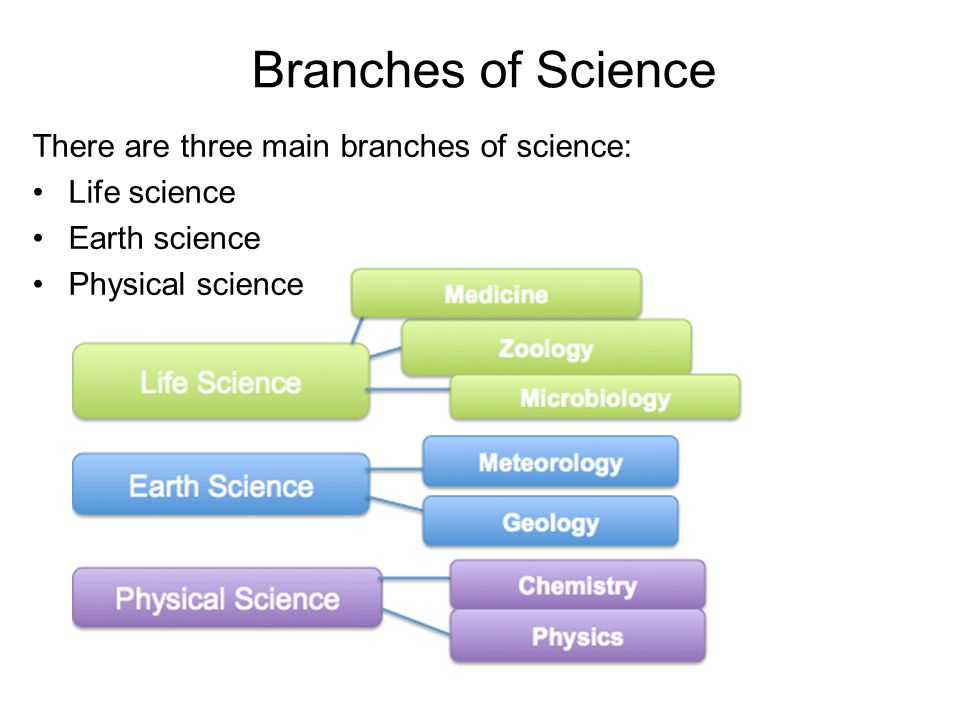
The Branches of science includes:
1. CHEMISTRY
2. BIOLOGY
3. PHYSICS
4. MATHEMATICS.
EVALUATION
1. Define the word science.
2. State three major branches of science
LESSON 2
Science Related Occupations
There are so many science related occupations which include the following
Engineering, Architecture, Pharmacy, Medical Doctor, Sociologists, Geologists, Biologists, Botanists, Driving, Aeronautic Engineer, etc.
A scientists

Engineers (building site)

Reasons Why we Study Science
There are many reasons why we study science. As scientists we do the following
I. Ask questions
II. Observe
III. Record
IV. Sorting out things
V. Make guesses (hypothesis)
VI. Carry out experiments
VII. Make conclusion

Microscope
Scientists also find out about things using their senses.
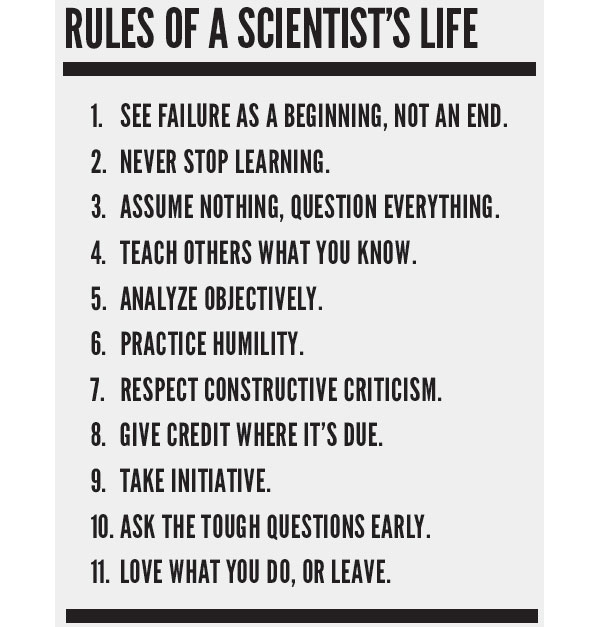
EVALUATION
1. List five processes used by scientists when trying to solve a scientific problem.
2. Which organs do we use for the following activities:
(a) Seeing
(b) Hearing
(c) Smelling
3. List 2 science related occupation. How can you become one the two listed.
ASSIGNMENT
Describe three problems that you think can be answered by science.
READING ASSIGNMENT:
Nigeria Basic Science Project by STAN page 1-14.
MEANING AND DEFINITION OF SCIENCE
OBJECTIVE: At the end of the lesson, the students should be able to:
1. Define science.
2. State the aims of science

CONTENT:
LEARNING ABOUT SCIENCE
Science is the study of matter in a systematic manner. Matter is anything that has weight or mass and occupies space. A person who studies science is a scientist.
When study is carried out systematically, desired results are obtained. Some of the processes involved in scientific study are: observation, recording, inferring, experimenting, hypothesizing etc.
AIMS OF SCIENCE
1. Science helps to solve our everyday problems.
2. Helps us to find out more about our environment.
3. It helps us to get the best out of the resources around us.
4. It helps us to avoid disaster.
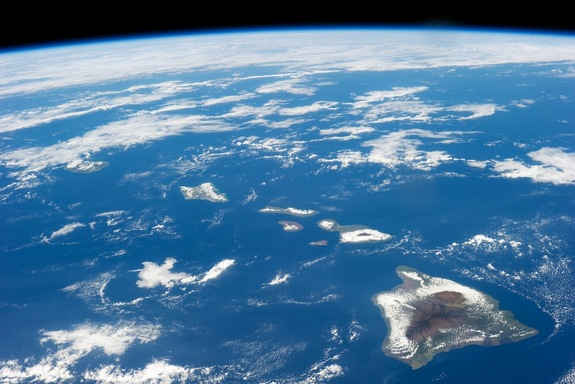
EVALUATION:
What is science?
What are the aims of science?
ASSIGNMENT:
Mention 10 science related occupations.
watch video
https://youtu.be/Tw5Bg0CJYs0
https://youtu.be/6Lt2nWQCD9g
LESSON 2
TOPIC: BRANCHES OF SCIENCE, SCIENCE RELATED OCCUPATIONS
OBJECTIVE: At the end of the lesson, the students should be able to:
1. Mention the branches of science.
2. Give examples of science related occupations.
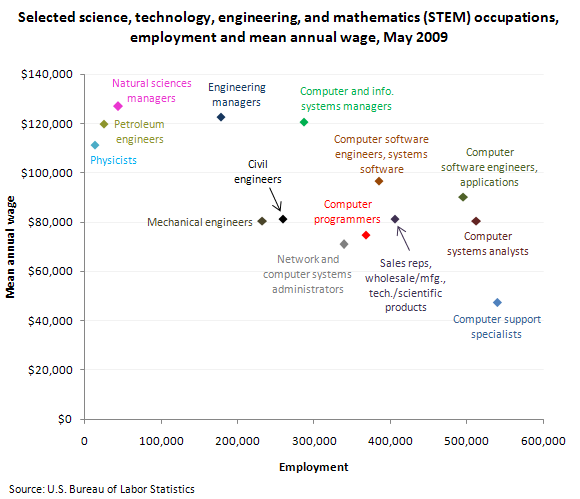
CONTENT:
BRANCHES OF SCIENCE
Science is broadly divided into two major fields:
1. Physical sciences
2. Biological sciences
Physical Sciences
The physical sciences are concerned with the study of non living matter, their properties and behavior.
Physical sciences are further divided into 2 namely:
(a) Physics: this is concerned with matter in relation to energy.
(b) Chemistry: this deals with actions of one kind of substance on another

Biological Sciences
These are sciences that deal with living things. Biology is the study of living things.
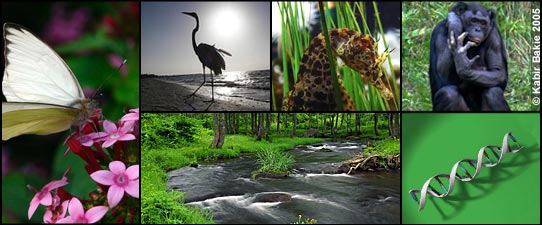
SCIENCE RELATED OCCUPATIONS
There are quite a number of professions that require in depth knowledge of science. Examples of such professions are medicine, geology, engineering, pharmacy, physiotherapy, dentistry, astrology, biochemistry, botany etc.
EVALUATION
What are the branches of science?
What are science related occupations?
ASSIGNMENT
Differentiate between pure and applied science.
Mention the JSS subjects related to both physical and biological sciences.
further studies
Study More...
practice test
Short Practice Quiz
watch video
https://youtu.be/1ulk9fHe3LI
LESSON 3
TOPIC: REASONS WHY WE STUDY SCIENCE
OBJECTIVE: At the end of the lesson, the students should be able to:
1. Mention the reasons for studying science.
CONTENT:
REASONS FOR STUDYING SCIENCE
We study science for the following reasons:
1. It helps to develop our five senses.
2. It helps us to know more about our environment.
3. It assists us in understanding how our body systems function.
4. It helps us to work on our nutritional problems.
5. It makes us active.
EVALUATION
What are the reasons for studying science?
Draw a hand lens and mention its uses.
practice test
Short Practice Quiz
TOPIC: - ORIENTATION - LEARNING ABOUT SCIENCE
CONTENT
1. Meaning, definition of science and Branches of science
2. Science related occupations
3. Reasons why we study science
Basic science is concerned with all aspects and branches of science put together
MEANING AND DEFINITION OF SCIENCE
Science is an exciting and dynamic subject. Science deals with experiments ( practical work) to help in answering the various questions. It affect our everyday activities. Science can be defined as a reliable body of knowledge about living and non-living things, our environment, about natural events and occurrences. Scientists asks and answers a lot of questions. A person who studies science is called a scientist.
Branches of science

The Branches of science includes:
1. CHEMISTRY
2. BIOLOGY
3. PHYSICS
4. MATHEMATICS.
EVALUATION
1. Define the word science.
2. State three major branches of science
LESSON 2
Science Related Occupations
There are so many science related occupations which include the following
Engineering, Architecture, Pharmacy, Medical Doctor, Sociologists, Geologists, Biologists, Botanists, Driving, Aeronautic Engineer, etc.
A scientists

Engineers (building site)

Reasons Why we Study Science
There are many reasons why we study science. As scientists we do the following
I. Ask questions
II. Observe
III. Record
IV. Sorting out things
V. Make guesses (hypothesis)
VI. Carry out experiments
VII. Make conclusion

Microscope
Scientists also find out about things using their senses.

EVALUATION
1. List five processes used by scientists when trying to solve a scientific problem.
2. Which organs do we use for the following activities:
(a) Seeing
(b) Hearing
(c) Smelling
3. List 2 science related occupation. How can you become one the two listed.
ASSIGNMENT
Describe three problems that you think can be answered by science.
READING ASSIGNMENT:
Nigeria Basic Science Project by STAN page 1-14.
MEANING AND DEFINITION OF SCIENCE
OBJECTIVE: At the end of the lesson, the students should be able to:
1. Define science.
2. State the aims of science

CONTENT:
LEARNING ABOUT SCIENCE
Science is the study of matter in a systematic manner. Matter is anything that has weight or mass and occupies space. A person who studies science is a scientist.
When study is carried out systematically, desired results are obtained. Some of the processes involved in scientific study are: observation, recording, inferring, experimenting, hypothesizing etc.
AIMS OF SCIENCE
1. Science helps to solve our everyday problems.
2. Helps us to find out more about our environment.
3. It helps us to get the best out of the resources around us.
4. It helps us to avoid disaster.

EVALUATION:
What is science?
What are the aims of science?
ASSIGNMENT:
Mention 10 science related occupations.
watch video
https://youtu.be/Tw5Bg0CJYs0
https://youtu.be/6Lt2nWQCD9g
LESSON 2
TOPIC: BRANCHES OF SCIENCE, SCIENCE RELATED OCCUPATIONS
OBJECTIVE: At the end of the lesson, the students should be able to:
1. Mention the branches of science.
2. Give examples of science related occupations.

CONTENT:
BRANCHES OF SCIENCE
Science is broadly divided into two major fields:
1. Physical sciences
2. Biological sciences
Physical Sciences
The physical sciences are concerned with the study of non living matter, their properties and behavior.
Physical sciences are further divided into 2 namely:
(a) Physics: this is concerned with matter in relation to energy.
(b) Chemistry: this deals with actions of one kind of substance on another

Biological Sciences
These are sciences that deal with living things. Biology is the study of living things.

SCIENCE RELATED OCCUPATIONS
There are quite a number of professions that require in depth knowledge of science. Examples of such professions are medicine, geology, engineering, pharmacy, physiotherapy, dentistry, astrology, biochemistry, botany etc.
EVALUATION
What are the branches of science?
What are science related occupations?
ASSIGNMENT
Differentiate between pure and applied science.
Mention the JSS subjects related to both physical and biological sciences.
further studies
Study More...
practice test
Short Practice Quiz
watch video
https://youtu.be/1ulk9fHe3LI
LESSON 3
TOPIC: REASONS WHY WE STUDY SCIENCE
OBJECTIVE: At the end of the lesson, the students should be able to:
1. Mention the reasons for studying science.
CONTENT:
REASONS FOR STUDYING SCIENCE
We study science for the following reasons:
1. It helps to develop our five senses.
2. It helps us to know more about our environment.
3. It assists us in understanding how our body systems function.
4. It helps us to work on our nutritional problems.
5. It makes us active.
EVALUATION
What are the reasons for studying science?
Draw a hand lens and mention its uses.
practice test
Short Practice Quiz
WEEK 2
LESSON 4
Topic: SCIENTIFIC METHODS
Content:
1. Meaning of scientific methods
2. Explanation of terms
MEANING OF SCIENTIFIC METHODS
These are methods used by the scientists to find answers or solutions to various questions and problems identified. Scientific methods include:
i. Identifying a problem
ii. Observation
iii. Experimentation
iv. Making hypothesis
v. Recording
vi. Interpretation
vii. Drawing conclusion.
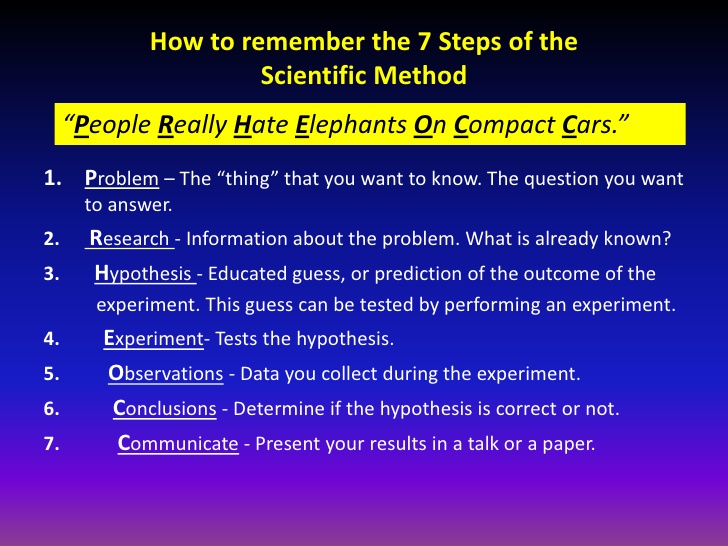
Scientists Sort Things out: They can sort things out by colour, sound, by sex, such as boys from girls or sorted out according to performance in class test, or sorted out by colour, shape, size, weight, roughness, how they respond to things that are done to them. These facts about things are called their properties.
EVALUATION
1. List five properties used by the scientists in sorting out things.
2. Identify six processes/methods used by scientist to find solutions to their numerous questions.
LESSON 5
EXPLANATION OF TERMS
Identifying a Problem: Scientists are very inquisitive. They are always asking questions so as to know why things are the way they are and find solutions to those questions.
Observation: Scientists observe objects very well by making use of their five senses which are eyes, hands, skin, noses and tongues. In a science lesson, it is dangerous to taste because some objects are poisonous.
Experimentation: A scientist also carries out experiment and writes down what they do and observe in the experiment. It is a practical way of finding solution to their questions. There are various equipments used by the scientist which include computer, Bunsen burner microscope, test-tubes, thermometer, etc.
Telescope
Telescopes help us see things that are far away. They make distant objects look bigger.

Making Hypothesis (Making Guesses): After scientists have sorted out things, the only way they could get any further was by making guesses and then doing experiments to see if they are right. Scientists call a guess like this a hypothesis.
Recording: Recording is the art of writing down what has been observed in the course of the experiment. This is to remind them what they have done, what they have seen and what they have found out, or perhaps, they might be asked to draw a picture of the experiment.
Interpretation: There are many interpretations to be made from the experiment like observing reading. Its involves the analyzing the experiment.
Drawing conclusion: The purpose of this is to be sure if the experiment answers /supports the hypothesis rightly or not. If it is right, the experiment is repeated several times to get the same result again and again.
EVALUATION
1. Highlight five processes adopted by scientists to answer some of their questions.
2. Mention five equipments used by the scientists for their work.
ASSIGNMENT
Identify and state the uses of seven science equipments.
READING ASSIGNMENT
Nigeria Basic Science Project by STAN pages 8-14
LESSON 6
TOPIC: SCIENTIFIC METHODS
OBJECTIVE: At the end of the lesson, the students should be able to:
1.Define the method of science.
2.Mention the steps or sequence of the scientific method.
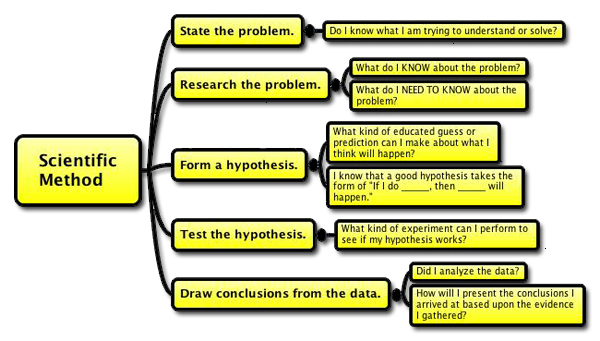
CONTENT:
The process or method of science involves the sequence of making enquiries about an object or thing under study in science. Students of science have to learn to make clear, systematic and accurate account of their scientific investigations.
Scientific methods therefore begin with observation which involves the use of senses to describe what one has seen or felt about an object.
The observation then leads to the classification, then to the inference and later to measurement and identification of the existing problems.
After that, the scientist now forms hypothesis or a tentative answer. The hypothesis is now tested by an experiment.
EVALUATION
What is the method of science?
What are the steps of the scientific method?
ASSIGNMENT
Define identification
Differentiate between classification and measurement.
further studies
Study More...
practice test
Short Practice Quiz
view slide show
https://drive.google.com/file/d/0Bz3Mh6 ... sp=sharing
LESSON 7
TOPIC: SCIENTIFIC METHODS (CONTD)
OBJECTIVE: At the end of the lesson, the students should be able to:
1. Define apparatus.
2. Define method.
3. Define observation.
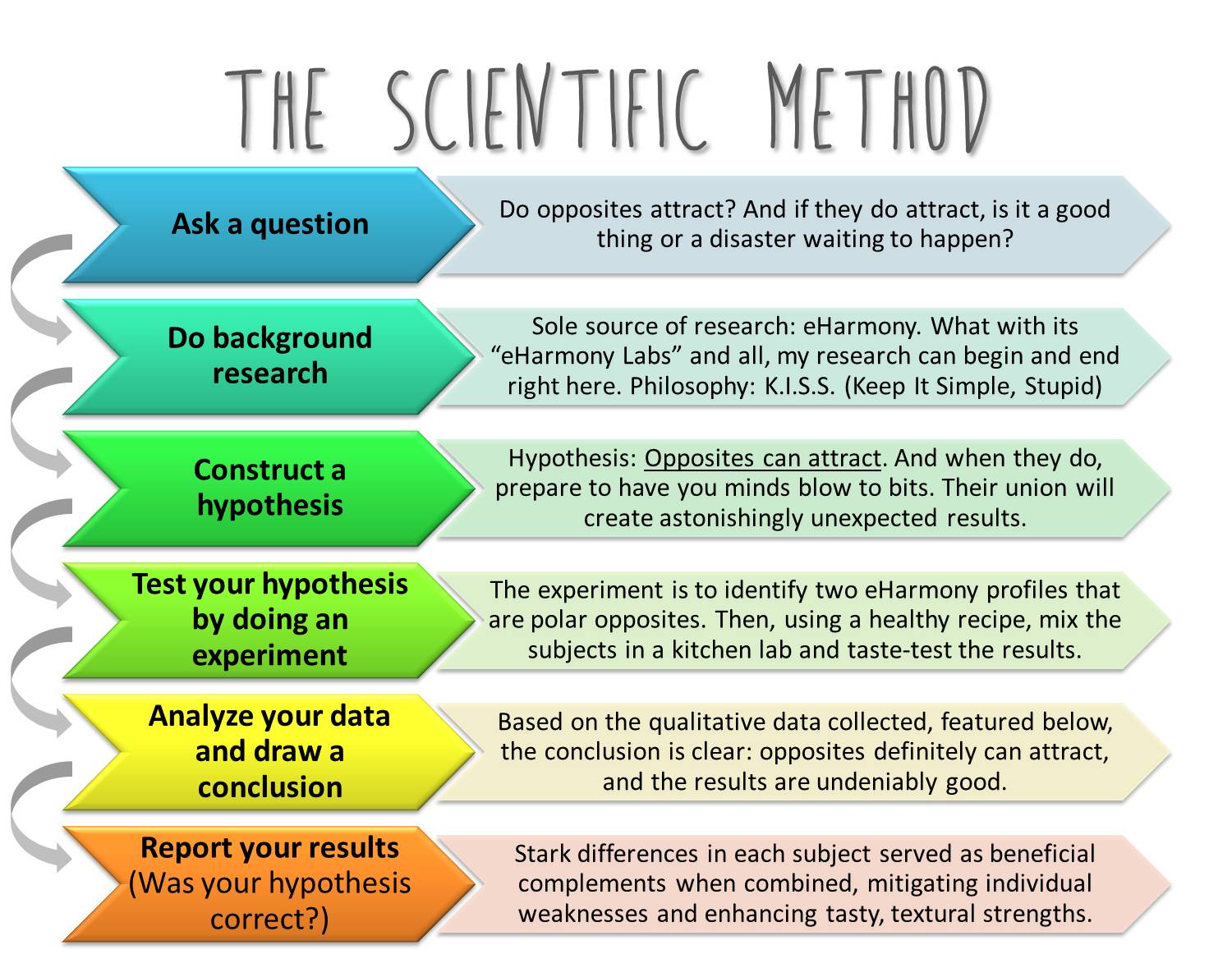
https://youtu.be/BVfI1wat2y8
CONTENT:
After the identification, the scientist now forms hypothesis or a tentative answer. The hypothesis is now tested by an experiment. In reporting, it is very important to use or follow the pattern laid down by scientists. This pattern includes:
(1) Aim: this is to state the purpose of the experiment.
(2) Apparatus: this includes the materials that will be used in the experiment.
(3) Method: this is to describe in detail, the procedures that are required or the step by step procedure of the experiment.
(4) Observation: this records what one has seen during and after the experiment has been set up.
(5) Conclusion: this is to draw conclusions on the outcome of the whole experiment based on the final result and observations.
EVALUATION:
What is apparatus?
What is method?
What is observation?
ASSIGNMENT:
Report an experiment of cooking rice at home following the scientific pattern taught.
Write a short note on your aim in your present class.
further studies
Study More...
practice test
Practice Quiz...
LESSON 8
TOPIC: SCIENTIFIC METHODS (CONTD)
OBJECTIVES: At the end of the lesson, the students should be able to:
1. Describe control experiment
2. Tell the type of acid present in an unripe orange.
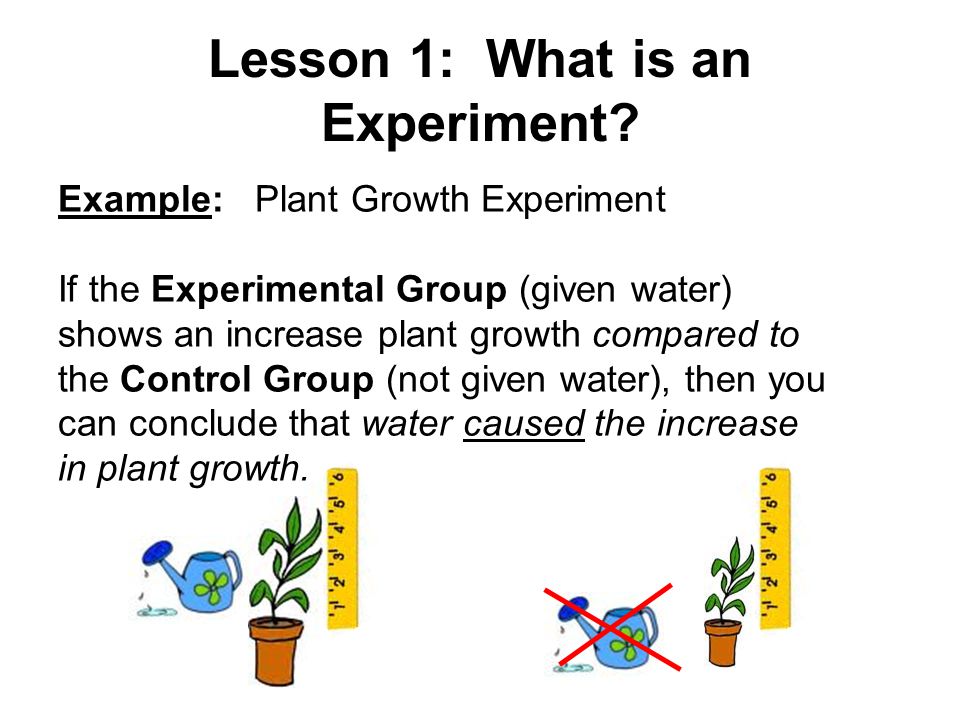
CONTENT:
In preparing an experiment, a science student needs to take note of control experiment. In control experiment, the scientist makes sure that during the experiment, the organism or object being observed is not deprived of the particular factor being investigated.
The end of the experiment can then be used to show whether the hypothesis is true or false.

EVALUATION:
What is control experiment?
What acid is present in an unripe orange?
ASSIGNMENT:
Mention 10 things you can observe in your classroom.
practice test
Practice Quiz...
Topic: SCIENTIFIC METHODS
Content:
1. Meaning of scientific methods
2. Explanation of terms
MEANING OF SCIENTIFIC METHODS
These are methods used by the scientists to find answers or solutions to various questions and problems identified. Scientific methods include:
i. Identifying a problem
ii. Observation
iii. Experimentation
iv. Making hypothesis
v. Recording
vi. Interpretation
vii. Drawing conclusion.

Scientists Sort Things out: They can sort things out by colour, sound, by sex, such as boys from girls or sorted out according to performance in class test, or sorted out by colour, shape, size, weight, roughness, how they respond to things that are done to them. These facts about things are called their properties.
EVALUATION
1. List five properties used by the scientists in sorting out things.
2. Identify six processes/methods used by scientist to find solutions to their numerous questions.
LESSON 5
EXPLANATION OF TERMS
Identifying a Problem: Scientists are very inquisitive. They are always asking questions so as to know why things are the way they are and find solutions to those questions.
Observation: Scientists observe objects very well by making use of their five senses which are eyes, hands, skin, noses and tongues. In a science lesson, it is dangerous to taste because some objects are poisonous.
Experimentation: A scientist also carries out experiment and writes down what they do and observe in the experiment. It is a practical way of finding solution to their questions. There are various equipments used by the scientist which include computer, Bunsen burner microscope, test-tubes, thermometer, etc.
Telescope
Telescopes help us see things that are far away. They make distant objects look bigger.

Making Hypothesis (Making Guesses): After scientists have sorted out things, the only way they could get any further was by making guesses and then doing experiments to see if they are right. Scientists call a guess like this a hypothesis.
Recording: Recording is the art of writing down what has been observed in the course of the experiment. This is to remind them what they have done, what they have seen and what they have found out, or perhaps, they might be asked to draw a picture of the experiment.
Interpretation: There are many interpretations to be made from the experiment like observing reading. Its involves the analyzing the experiment.
Drawing conclusion: The purpose of this is to be sure if the experiment answers /supports the hypothesis rightly or not. If it is right, the experiment is repeated several times to get the same result again and again.
EVALUATION
1. Highlight five processes adopted by scientists to answer some of their questions.
2. Mention five equipments used by the scientists for their work.
ASSIGNMENT
Identify and state the uses of seven science equipments.
READING ASSIGNMENT
Nigeria Basic Science Project by STAN pages 8-14
LESSON 6
TOPIC: SCIENTIFIC METHODS
OBJECTIVE: At the end of the lesson, the students should be able to:
1.Define the method of science.
2.Mention the steps or sequence of the scientific method.

CONTENT:
The process or method of science involves the sequence of making enquiries about an object or thing under study in science. Students of science have to learn to make clear, systematic and accurate account of their scientific investigations.
Scientific methods therefore begin with observation which involves the use of senses to describe what one has seen or felt about an object.
The observation then leads to the classification, then to the inference and later to measurement and identification of the existing problems.
After that, the scientist now forms hypothesis or a tentative answer. The hypothesis is now tested by an experiment.
EVALUATION
What is the method of science?
What are the steps of the scientific method?
ASSIGNMENT
Define identification
Differentiate between classification and measurement.
further studies
Study More...
practice test
Short Practice Quiz
view slide show
https://drive.google.com/file/d/0Bz3Mh6 ... sp=sharing
LESSON 7
TOPIC: SCIENTIFIC METHODS (CONTD)
OBJECTIVE: At the end of the lesson, the students should be able to:
1. Define apparatus.
2. Define method.
3. Define observation.

https://youtu.be/BVfI1wat2y8
CONTENT:
After the identification, the scientist now forms hypothesis or a tentative answer. The hypothesis is now tested by an experiment. In reporting, it is very important to use or follow the pattern laid down by scientists. This pattern includes:
(1) Aim: this is to state the purpose of the experiment.
(2) Apparatus: this includes the materials that will be used in the experiment.
(3) Method: this is to describe in detail, the procedures that are required or the step by step procedure of the experiment.
(4) Observation: this records what one has seen during and after the experiment has been set up.
(5) Conclusion: this is to draw conclusions on the outcome of the whole experiment based on the final result and observations.
EVALUATION:
What is apparatus?
What is method?
What is observation?
ASSIGNMENT:
Report an experiment of cooking rice at home following the scientific pattern taught.
Write a short note on your aim in your present class.
further studies
Study More...
practice test
Practice Quiz...
LESSON 8
TOPIC: SCIENTIFIC METHODS (CONTD)
OBJECTIVES: At the end of the lesson, the students should be able to:
1. Describe control experiment
2. Tell the type of acid present in an unripe orange.

CONTENT:
In preparing an experiment, a science student needs to take note of control experiment. In control experiment, the scientist makes sure that during the experiment, the organism or object being observed is not deprived of the particular factor being investigated.
The end of the experiment can then be used to show whether the hypothesis is true or false.

EVALUATION:
What is control experiment?
What acid is present in an unripe orange?
ASSIGNMENT:
Mention 10 things you can observe in your classroom.
practice test
Practice Quiz...
WEEK 3
LESSON 9
TOPIC: - FAMILY HEALTH (CLEANLINESS)
QUOTE: “Let it be observed, that slovenliness is no part of religion; that neither
this, nor any text of Scripture condemns neatness of apparel.
Certainly this is a duty, not a sin”.
'Cleanliness is, indeed, next to Godliness’.
- John Wesley
Content:
(1) Personal cleanliness.
(2) Meaning of personal cleanliness
(3) Methods of maintaining personal cleanliness
(4) Advantages and disadvantages of personal cleanliness.
PERSONAL CLEANLINESS
Personal cleanliness is important for health because it kills very tiny organisms (micro-organisms) which can cause disease. It does not require much effort.
Personal cleanliness is keeping of ones body and his personal belongings neat, clean and tidy always.
Good personal health is a state of well-being of the whole body. Good health can be maintained by
(I) Doing exercise
(II) Eating a balanced diet
(III) Maintaining personal cleanliness
(IV) Avoiding habits such as smoking and drinking alcohol
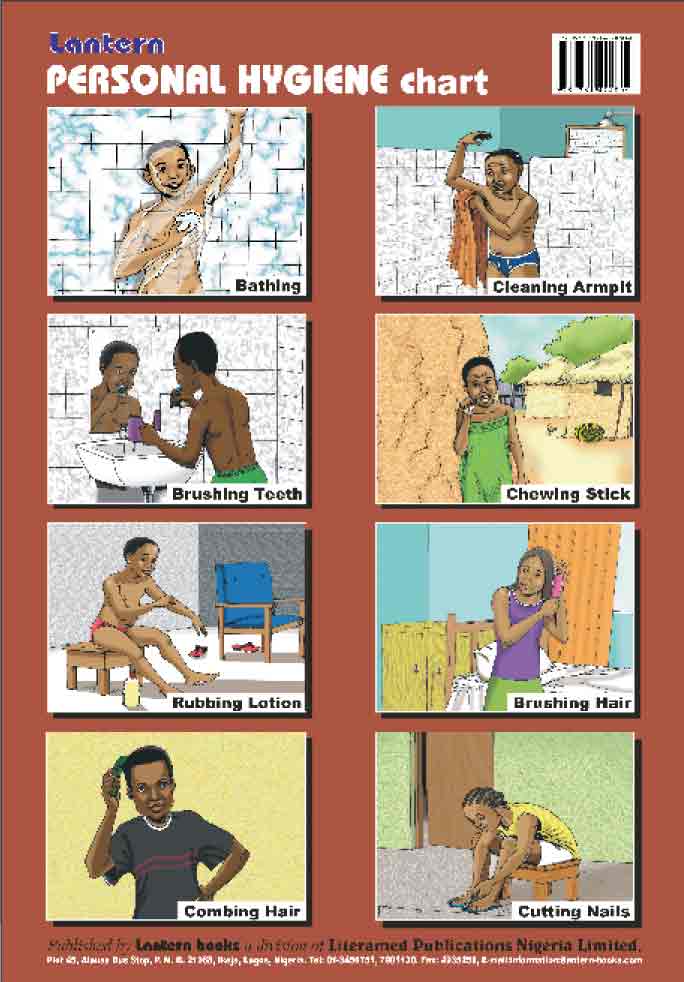
METHODS OF PERSONAL CLEANLINESS
1. Cleanliness of your hair: Hair should be washed and combed every day. Plaited or braided hair should be brushed everyday and washed once a week. Hair must be kept clean to stop parasites, such as lice and fleas living in it.
2. Cleanliness of your skin/regular bath: Skin is the covering of body. It secretes sweat. Sweat is sticky and can cause an unpleasant smell. The skin can provide a breeding ground for parasites such as lice, scabies mites and micro-organisms. To avoid this you should wash your body using soap once or twice a day.
3. Cleanliness of your teeth, hands and nails: Teeth should be clean with a chewing stick or with toothpaste and a brush every morning and at night before going to bed. Cleaning removes food particles that can decay and encourage the growth of harmful micro-organisms. Wash your hands before meal and after going to the toilet or handling dirty things. Brush nails with a nail brush when you wash your hands. Keep your nails short.
4. Cleanliness of your clothes,( under-wears) and shoes: Clothes absorb sweat. You should change clothes every day and washed before wearing them again. Shoes should be cleaned and dried properly after use.
5. Cleanliness of our homes: Our homes must be kept clean at all times for healthy living. We should sweep and dust furniture, clear bushes around the home and toilets should be flushed and kept clean.
EVALUATION
1. Make a list of the things you have to do each day to make sure that your body is clean
2. Explain the word micro-organisms.
LESSON 10
Sub-Topic 2: ADVANTAGES OF OBSERVING PERSONAL CLEANLINESS
When personal cleanliness is observed, we enjoy the following
(a) You look attractive and beautiful.
(b) You will be lively and healthy.
(c) You will be emotionally balanced
(d) You will be regular and punctual at school and at work.
(e) One will be socially acceptable.
(f) Germs will not breed on your food or other edible materials.
(g) The brain will be at alert.
DISADVANTAGES OF NOT OBSERVING PERSONAL CLEANLINESS:
(a) Poor health
(b) Spread of diseases
(c) Death
(d) Emotional instability
(e) Low self esteem among others
(f) Money will be wasted on drugs and hospital.
EVALUATION
1. What are the advantages and disadvantages of observing and not observing personal cleanliness?
2. Make a list of rules that you would observe to keep in good health.
ASSIGNMENT
1. Name four materials required for keeping healthy.
2. State the effects of exercise on health.
PRE-READING ASSIGNMENT
Nigeria Basic Science Project by STAN pages44-47
LESSON 11
TOPIC: FAMILY HEALTH (CLEANLINESS)
OBJECTIVE: At the end of the lesson, the students should be able to:
1. Define personal hygiene.
2. Mention ways of cleaning the human body.
3. Enumerate the cleaning agents for the ear.

CONTENT:
FAMILY HEALTH (CLEANLINESS)
Personal cleanliness means keeping one's body, clothes and shoes in a clean and neat condition, all the time.
METHODS OF KEEPING THE HUMAN BODY CLEAN
Each part of the human body has a special way of keeping it clean. The methods of keeping some selected parts of the human body clean are described below.
1. THE HUMAN BODY: the human body should be washed in the morning and last thing at night with water, soap and sponge. After wash, the body should be rinsed with clean water. This is because we live in a hot country in which people frequently sweat. If the body is not washed daily, the sweat dries on the skin and produces an odour. Besides, harmful micro organisms grow on the dry sweat on the skin. The body should also be washed after games or serious manual labour.

2. FINGER AND TOE NAILS: when the finger and toe nails grow all the time, they collect dirt between the finger or toe nails and the skin. Micro-organisms grow in this dirt and can easily contaminate food as we eat. Finger and toe nails can be kept clean by cutting them short with nail clippers or razor blades and by washing the tips of our fingers and our toes as we wash our bodies.
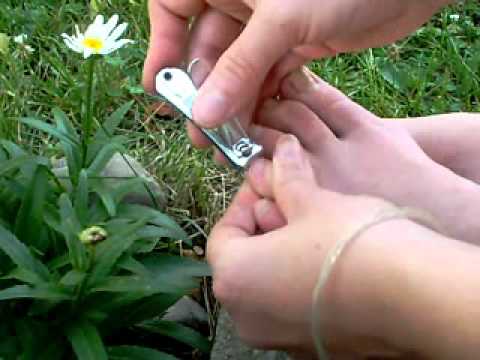
3. EAR: the ear lobe should be washed along with our parts of the body. The ear passage should be cleaned with cotton wool, never with sharp objects. Sharp objects can damage the ear drum without a chance of recovery.
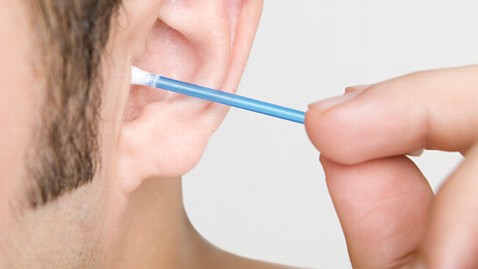
EVALUATION:
What is personal hygiene?
What are the ways of cleaning the human body?
What are the cleaning agents for the ear?
further studies
Teaching Your Child Good Personal Hygiene
Teaching the basics of proper personal hygiene is important for keeping kids healthy and clean. It's especially important for grade-schoolers to practice good hygiene -- particularly hand washing -- because they spend so much of their time in close contact with each other in the classroom, sharing everything from desks and chairs to germs. And when your grade-schooler reaches adolescence, hormonal changes will lead to increased production of oils in skin and hair and more stinkiness in body odor. That's when you will be glad you didn't wait till then to instill good health and hygiene habits! Some good personal hygiene practices to teach your child:
Teach proper hand washing.
The most important health and hygiene habit to teach your child is to wash her hands, especially after coming home from school or playing outside and before eating. Hand washing is, without a doubt, one of the best ways to prevent the spread of germs and illnesses. With younger grade-schoolers, you may need to remind them from time to time not to splash and dash -- run their hands for two seconds under the tap without soap and call it done. Make sure your child uses soap and lathers for at least 15 seconds (with the tap turned off to conserve water) before rinsing.
Teach him to cover sneezes and coughs.
Germs can travel far and wide on a sneeze or a cough. Get your child into the habit of covering his mouth and nose with a tissue (or his arm if he can't reach a tissue fast enough) when he sneezes or coughs.
Remind her not to touch her eyes or mouth or to pick her nose.
Germs can easily enter the body through the mucous membranes of the eyes and through the nose and mouth.
Encourage good dental health and hygiene.
Grade-school age children have the motor skills necessary to do a fairly good job of brushing teeth on their own (though you may still want to take a quick turn until he's 6 or 7). Get your child into the habit of flossing, and if he has bad breath, have him gently scrape the back of his tongue with his toothbrush. Get a fun timer to help your child brush longer, like a cool little hourglass filled with blue sand.
Set up regular bath times.
Many parents find that evening baths are a nice way to relax a child before bed. And bathing the night before can help ease the morning rush. Some grade-schoolers prefer showers, which can also save a lot of time on a busy school night or morning. Showers can also save water. Many kids can shower on their own starting around age 6. You may want to supervise the shampooing and rinsing till she gets the hang of it. And be sure to put down a secure bath mat to prevent any slips on the wet floor when she's done.
LESSON 12
TOPIC: METHODS OF KEEPING THE HUMAN BODY CLEAN
OBJECTIVE: At the end of the lesson, the students should be able to:
1. Demonstrate the movement of brushing the teeth correctly.
2. State when to wash the hair.
3. Enumerate how and when the hands should be washed.
CONTENT:
4. TEETH: the teeth should be brushed with a tooth brush and tooth paste or with chewing stick first thing in the morning and last thing before going to bed at night. The correct way to use a toothbrush is to brush the teeth in an up and down movement, not a side-to-side movement.
It is a good habit to wash the teeth after each meal, to remove particles of food, which stick to the teeth and attract bacteria that cause toothache and tooth decay.
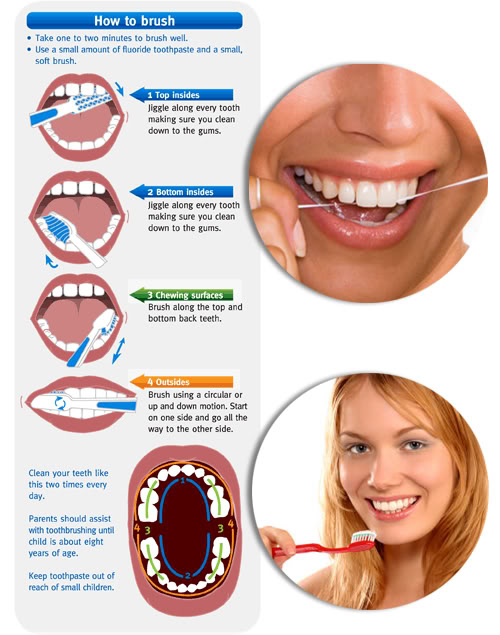
5. HAIR: the hair (especially short hair) should be washed daily while washing the body or whenever it is dirty. The hair should be cut short so as to be easily kept clean. Dirty hair has an odour and attracts parasites such as lice and skin diseases such as dandruff.
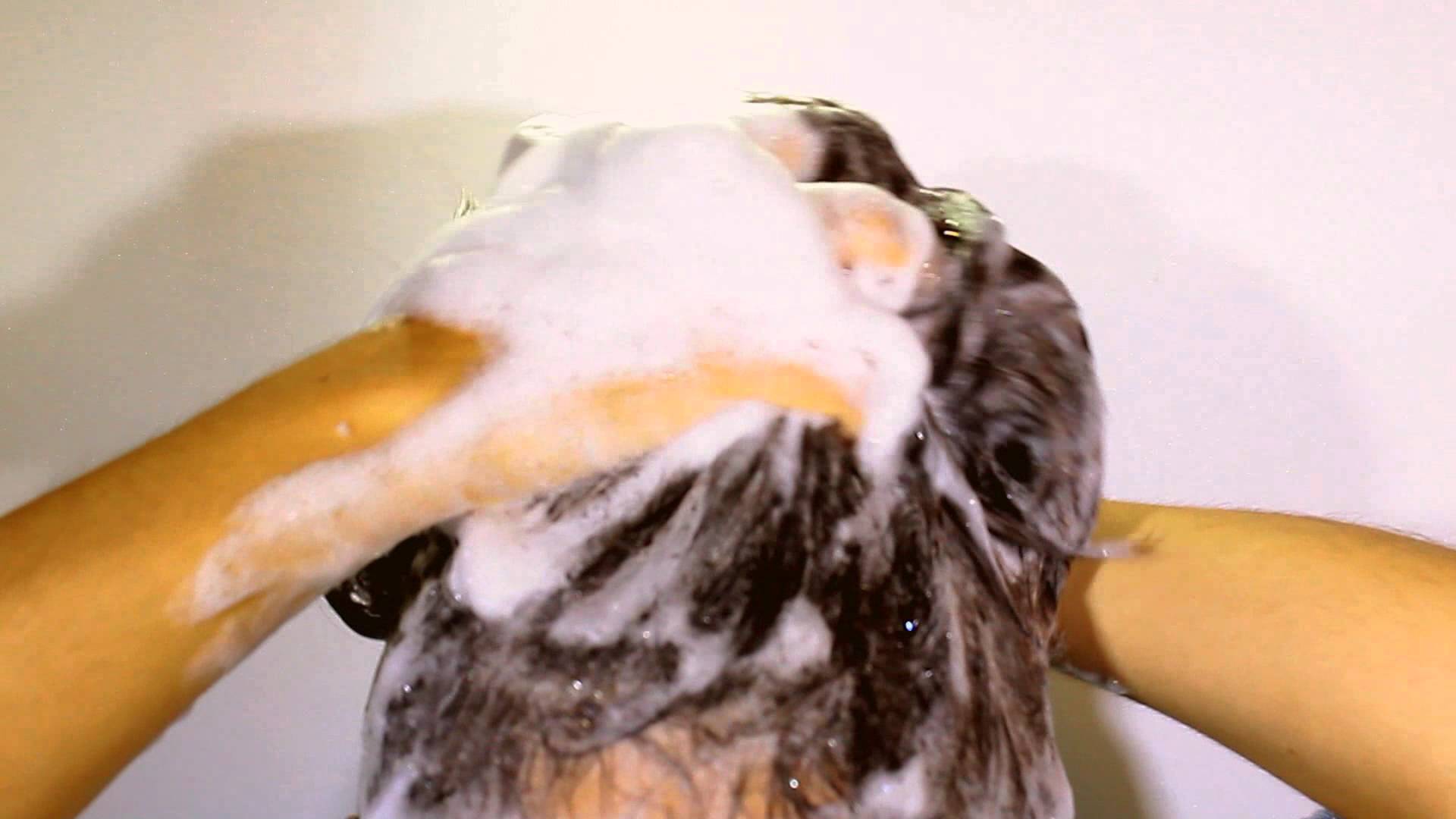
6. HANDS: hands should be washed with soap and water after:-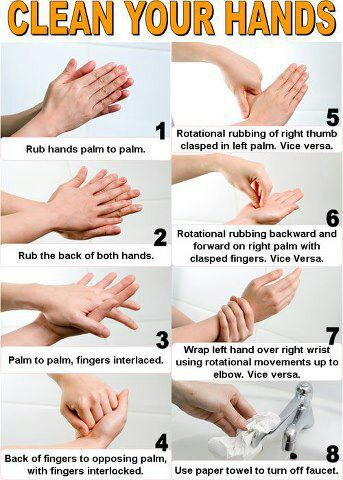
7. FEET: the feet should be washed with soap and water whenever they are dirty, in addition to regular washing along with the rest of the body.
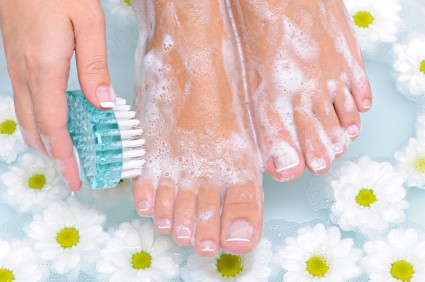
8. CLOTHES: clothes should be washed, dried in the sun (or in a drier) and ironed to look neat. Dirty clothes should not be packed in a box or hung in a wardrobe. The odour given out by the dirty clothes may attract cockroaches which may eat and damage the dirty clothes.
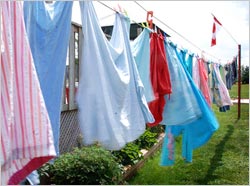
9. SHOES: shoes should be cleaned with a moist or dry piece of cloth as necessary, and then polished to look neat.

EVALUATION:
How should the teeth be brushed correctly?
When should the hair be washed?
When and how should the hands be washed?
ASSIGNMENT:
Mention 4 parts of the home.
How should each part mentioned be cleaned?
http://www.cyh.com/HealthTopics/HealthT ... 89&id=2146
watch video
https://www.youtube.com/watch?v=Wf97KwUa_7I
LESSON 13
TOPIC: ADVANTAGES OF PERSONAL CLEANLINESS
OBJECTIVE: At the end of the lesson, students should be able to:
1. Explain how clothes should be cleaned.
2. Mention the advantages of personal cleanliness.
3. Enumerate the disadvantages of personal uncleanliness.
CONTENT:
The advantages of personal cleanliness include:
(1) We reduce the disease causing micro organisms that come in contact with us.
(2) We enjoy good health.
(3) We can do our normal work such as going to school regularly.
(4) As a result of good health, we save money we might otherwise spend on medical treatment.
(5) We look neat.
http://www.livestrong.com/article/14072 ... l-hygiene/
DISADVANTAGES OF PERSONAL UNCLEANLINESS
(1) Disease causing organisms on our bodies, clothes, shoes in our homes, may enter our bodies and cause diseases.
(2) When we are sick, we cannot go to school or do our other duties.
(3) When we are sick, our parents spend money, which the family needs for other purposes, on medical bills.
(4) It makes us and our surrounding look untidy.
http://www.livestrong.com/article/25660 ... l-hygiene/
EVALUATION:
How should our clothes be cleaned?
What are the advantages of personal cleanliness?
What are the disadvantages of personal uncleanliness?
ASSIGNMENT:
Draw the following cleaning agents and state their uses:
(1) Tooth paste (2) toothbrush (3) detergent (4) broom
practice test
http://idiva.com/news-health/quiz-how-d ... iene/10857
http://www.quibblo.com/quiz/9Jup6Dh/Personal-Hygiene
TOPIC: - FAMILY HEALTH (CLEANLINESS)
QUOTE: “Let it be observed, that slovenliness is no part of religion; that neither
this, nor any text of Scripture condemns neatness of apparel.
Certainly this is a duty, not a sin”.
'Cleanliness is, indeed, next to Godliness’.
- John Wesley
Content:
(1) Personal cleanliness.
(2) Meaning of personal cleanliness
(3) Methods of maintaining personal cleanliness
(4) Advantages and disadvantages of personal cleanliness.
PERSONAL CLEANLINESS
Personal cleanliness is important for health because it kills very tiny organisms (micro-organisms) which can cause disease. It does not require much effort.
Personal cleanliness is keeping of ones body and his personal belongings neat, clean and tidy always.
Good personal health is a state of well-being of the whole body. Good health can be maintained by
(I) Doing exercise
(II) Eating a balanced diet
(III) Maintaining personal cleanliness
(IV) Avoiding habits such as smoking and drinking alcohol

METHODS OF PERSONAL CLEANLINESS
1. Cleanliness of your hair: Hair should be washed and combed every day. Plaited or braided hair should be brushed everyday and washed once a week. Hair must be kept clean to stop parasites, such as lice and fleas living in it.
2. Cleanliness of your skin/regular bath: Skin is the covering of body. It secretes sweat. Sweat is sticky and can cause an unpleasant smell. The skin can provide a breeding ground for parasites such as lice, scabies mites and micro-organisms. To avoid this you should wash your body using soap once or twice a day.
3. Cleanliness of your teeth, hands and nails: Teeth should be clean with a chewing stick or with toothpaste and a brush every morning and at night before going to bed. Cleaning removes food particles that can decay and encourage the growth of harmful micro-organisms. Wash your hands before meal and after going to the toilet or handling dirty things. Brush nails with a nail brush when you wash your hands. Keep your nails short.
4. Cleanliness of your clothes,( under-wears) and shoes: Clothes absorb sweat. You should change clothes every day and washed before wearing them again. Shoes should be cleaned and dried properly after use.
5. Cleanliness of our homes: Our homes must be kept clean at all times for healthy living. We should sweep and dust furniture, clear bushes around the home and toilets should be flushed and kept clean.
EVALUATION
1. Make a list of the things you have to do each day to make sure that your body is clean
2. Explain the word micro-organisms.
LESSON 10
Sub-Topic 2: ADVANTAGES OF OBSERVING PERSONAL CLEANLINESS
When personal cleanliness is observed, we enjoy the following
(a) You look attractive and beautiful.
(b) You will be lively and healthy.
(c) You will be emotionally balanced
(d) You will be regular and punctual at school and at work.
(e) One will be socially acceptable.
(f) Germs will not breed on your food or other edible materials.
(g) The brain will be at alert.
DISADVANTAGES OF NOT OBSERVING PERSONAL CLEANLINESS:
(a) Poor health
(b) Spread of diseases
(c) Death
(d) Emotional instability
(e) Low self esteem among others
(f) Money will be wasted on drugs and hospital.
EVALUATION
1. What are the advantages and disadvantages of observing and not observing personal cleanliness?
2. Make a list of rules that you would observe to keep in good health.
ASSIGNMENT
1. Name four materials required for keeping healthy.
2. State the effects of exercise on health.
PRE-READING ASSIGNMENT
Nigeria Basic Science Project by STAN pages44-47
LESSON 11
TOPIC: FAMILY HEALTH (CLEANLINESS)
OBJECTIVE: At the end of the lesson, the students should be able to:
1. Define personal hygiene.
2. Mention ways of cleaning the human body.
3. Enumerate the cleaning agents for the ear.

CONTENT:
FAMILY HEALTH (CLEANLINESS)
Personal cleanliness means keeping one's body, clothes and shoes in a clean and neat condition, all the time.
METHODS OF KEEPING THE HUMAN BODY CLEAN
Each part of the human body has a special way of keeping it clean. The methods of keeping some selected parts of the human body clean are described below.
1. THE HUMAN BODY: the human body should be washed in the morning and last thing at night with water, soap and sponge. After wash, the body should be rinsed with clean water. This is because we live in a hot country in which people frequently sweat. If the body is not washed daily, the sweat dries on the skin and produces an odour. Besides, harmful micro organisms grow on the dry sweat on the skin. The body should also be washed after games or serious manual labour.

2. FINGER AND TOE NAILS: when the finger and toe nails grow all the time, they collect dirt between the finger or toe nails and the skin. Micro-organisms grow in this dirt and can easily contaminate food as we eat. Finger and toe nails can be kept clean by cutting them short with nail clippers or razor blades and by washing the tips of our fingers and our toes as we wash our bodies.

3. EAR: the ear lobe should be washed along with our parts of the body. The ear passage should be cleaned with cotton wool, never with sharp objects. Sharp objects can damage the ear drum without a chance of recovery.

EVALUATION:
What is personal hygiene?
What are the ways of cleaning the human body?
What are the cleaning agents for the ear?
further studies
Teaching Your Child Good Personal Hygiene
Teaching the basics of proper personal hygiene is important for keeping kids healthy and clean. It's especially important for grade-schoolers to practice good hygiene -- particularly hand washing -- because they spend so much of their time in close contact with each other in the classroom, sharing everything from desks and chairs to germs. And when your grade-schooler reaches adolescence, hormonal changes will lead to increased production of oils in skin and hair and more stinkiness in body odor. That's when you will be glad you didn't wait till then to instill good health and hygiene habits! Some good personal hygiene practices to teach your child:
Teach proper hand washing.
The most important health and hygiene habit to teach your child is to wash her hands, especially after coming home from school or playing outside and before eating. Hand washing is, without a doubt, one of the best ways to prevent the spread of germs and illnesses. With younger grade-schoolers, you may need to remind them from time to time not to splash and dash -- run their hands for two seconds under the tap without soap and call it done. Make sure your child uses soap and lathers for at least 15 seconds (with the tap turned off to conserve water) before rinsing.
Teach him to cover sneezes and coughs.
Germs can travel far and wide on a sneeze or a cough. Get your child into the habit of covering his mouth and nose with a tissue (or his arm if he can't reach a tissue fast enough) when he sneezes or coughs.
Remind her not to touch her eyes or mouth or to pick her nose.
Germs can easily enter the body through the mucous membranes of the eyes and through the nose and mouth.
Encourage good dental health and hygiene.
Grade-school age children have the motor skills necessary to do a fairly good job of brushing teeth on their own (though you may still want to take a quick turn until he's 6 or 7). Get your child into the habit of flossing, and if he has bad breath, have him gently scrape the back of his tongue with his toothbrush. Get a fun timer to help your child brush longer, like a cool little hourglass filled with blue sand.
Set up regular bath times.
Many parents find that evening baths are a nice way to relax a child before bed. And bathing the night before can help ease the morning rush. Some grade-schoolers prefer showers, which can also save a lot of time on a busy school night or morning. Showers can also save water. Many kids can shower on their own starting around age 6. You may want to supervise the shampooing and rinsing till she gets the hang of it. And be sure to put down a secure bath mat to prevent any slips on the wet floor when she's done.
LESSON 12
TOPIC: METHODS OF KEEPING THE HUMAN BODY CLEAN
OBJECTIVE: At the end of the lesson, the students should be able to:
1. Demonstrate the movement of brushing the teeth correctly.
2. State when to wash the hair.
3. Enumerate how and when the hands should be washed.
CONTENT:
4. TEETH: the teeth should be brushed with a tooth brush and tooth paste or with chewing stick first thing in the morning and last thing before going to bed at night. The correct way to use a toothbrush is to brush the teeth in an up and down movement, not a side-to-side movement.
It is a good habit to wash the teeth after each meal, to remove particles of food, which stick to the teeth and attract bacteria that cause toothache and tooth decay.

5. HAIR: the hair (especially short hair) should be washed daily while washing the body or whenever it is dirty. The hair should be cut short so as to be easily kept clean. Dirty hair has an odour and attracts parasites such as lice and skin diseases such as dandruff.

6. HANDS: hands should be washed with soap and water after:-
- Manual labour.
- Attending a party where a lot of handshakes took place.
- Each visit to the toilet.
- Hands should also be washed before and after each meal.
- Whenever they are dirty.

7. FEET: the feet should be washed with soap and water whenever they are dirty, in addition to regular washing along with the rest of the body.

8. CLOTHES: clothes should be washed, dried in the sun (or in a drier) and ironed to look neat. Dirty clothes should not be packed in a box or hung in a wardrobe. The odour given out by the dirty clothes may attract cockroaches which may eat and damage the dirty clothes.

9. SHOES: shoes should be cleaned with a moist or dry piece of cloth as necessary, and then polished to look neat.

EVALUATION:
How should the teeth be brushed correctly?
When should the hair be washed?
When and how should the hands be washed?
ASSIGNMENT:
Mention 4 parts of the home.
How should each part mentioned be cleaned?
http://www.cyh.com/HealthTopics/HealthT ... 89&id=2146
watch video
https://www.youtube.com/watch?v=Wf97KwUa_7I
LESSON 13
TOPIC: ADVANTAGES OF PERSONAL CLEANLINESS
OBJECTIVE: At the end of the lesson, students should be able to:
1. Explain how clothes should be cleaned.
2. Mention the advantages of personal cleanliness.
3. Enumerate the disadvantages of personal uncleanliness.
CONTENT:
The advantages of personal cleanliness include:
(1) We reduce the disease causing micro organisms that come in contact with us.
(2) We enjoy good health.
(3) We can do our normal work such as going to school regularly.
(4) As a result of good health, we save money we might otherwise spend on medical treatment.
(5) We look neat.
http://www.livestrong.com/article/14072 ... l-hygiene/
DISADVANTAGES OF PERSONAL UNCLEANLINESS
(1) Disease causing organisms on our bodies, clothes, shoes in our homes, may enter our bodies and cause diseases.
(2) When we are sick, we cannot go to school or do our other duties.
(3) When we are sick, our parents spend money, which the family needs for other purposes, on medical bills.
(4) It makes us and our surrounding look untidy.
http://www.livestrong.com/article/25660 ... l-hygiene/
EVALUATION:
How should our clothes be cleaned?
What are the advantages of personal cleanliness?
What are the disadvantages of personal uncleanliness?
ASSIGNMENT:
Draw the following cleaning agents and state their uses:
(1) Tooth paste (2) toothbrush (3) detergent (4) broom
practice test
http://idiva.com/news-health/quiz-how-d ... iene/10857
http://www.quibblo.com/quiz/9Jup6Dh/Personal-Hygiene
WEEK 4
LESSON 14
TOPIC: FAMILY HEALTH (NUTRITION)
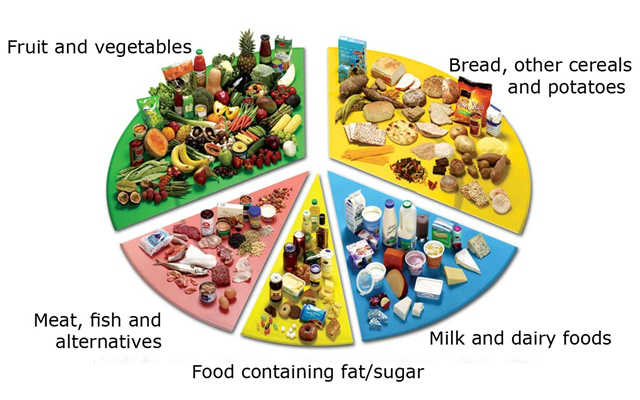
Content:
1. Food and adequate diet.
2. Type or composition of nutrition
3. Adequate diet
Food and Adequate Diet:
Food: Food is anything eaten to satisfy appetite and to meet physiological needs for growth, to maintain all body processes, and to supply energy to maintain body temperature and activity
Adequate/Balanced Diet: An adequate diet is that which is sufficient in quantity and food nutrients in the required amount/proportions or consists of a variety of foods in the right quantities and proportions to meet our needs.

Types of Food: This refers to the ways of grouping foods on various bases and purposes. Examples of food types are
i. Solid or liquid
ii. Local or imported
iii. Cereals, vegetables or fruits
iv. Eaten raw or cooked
Evaluation
1.Why is food important to you?
2. Define balance/adequate diet.
LESSON 15
Classes of Food Nutrients:
There are five main classes of nutrients found in food, namely carbohydrates, proteins, fat and oil, minerals salt and vitamins. Nutrient is a group of chemical compounds found in food .In an adequate diet, they become six including water.
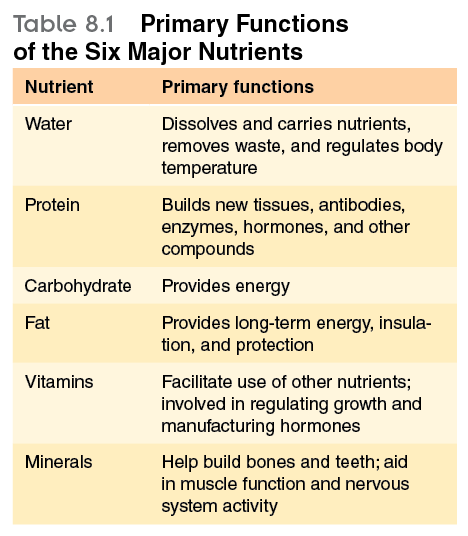
Carbohydrates: These are mainly concerned with supplying us with energy rice, yam, maize, cassava, etc.
Proteins: -These are food nutrients mainly concerned with growth and repair of parts of the body e.g meat, fish, eggs, beans, groundnut, milk, etc.
Fats: They supply us with energy, palm oil, groundnut oil, butter, margarine, e.t.c. they supplied us energy.
Vitamins: These consist of fruits and green leafy vegetables – vitamins aid digestion and sound health.
Mineral salts : It helps us to digest our food and form the hard parts of our skeleton.
– onions, milk, tomatoes, dried fish, okra, olives e.t.c.

EVALUATION
1. List food items which would make up a balanced or adequate breakfast, lunch and supper.
2. Differentiate between a meal and a balanced diet.
ASSIGNMENT
In a tabular form, identify the food nutrients and examples of their food items.
READING ASSIGNMENT: Read Stan pages 47-50.
LESSON 16
TOPIC: FAMILY HEALTH (NUTRITION)
OBJECTIVE: At the end of the lesson, the students should be able to:
1. Define food.
2. Mention types of food.
3. Give examples of types of food.
4. Enumerate the classes of food.

CONTENT:
FOOD:
Food is a thing which when eaten and digested, can be used by the body to provide energy, or substances that help in body building and repair or in preservation of health.
TYPES OF FOOD
Food may be grouped into types according to whether they are:
(1) Solid or liquid
(2) Local or imported
(3) Cereals, vegetables or fruits
(4) Eaten raw or cooked
Solid Foods ......Liquid Foods
Yam ..................Milk
Rice ..................Cocoa drink ( such as bournvita or milo)
Bread ...............Fruit juices
beans
Local foods ........Imported foods
Beans ................Milk
Yam ...................Stock fish
Sweet potato ....Pasta
Guinea corn .......cheese
Cereals ....Vegetables .....Fruits
Oats .........Spinach ..........Oranges
Corn flakes Water leaf .....Pear
Rice crispies Bitter leaf .....Water melon
....................Lettuce .........apple
Foods eaten raw ........Foods eaten cooked
Lettuce .........................Yam
Pawpaw ........................Potato
Cucumber ......................Fish
Carrot ...........................Meat

CLASSES AND COMPOSITION OF FOOD
Foods are grouped into classes based on the:-
(1) Chemical composition of the food.
(2) Nutrient present in the food.
Accordingly foods are grouped into six classes namely:
(1) Carbohydrates
(2) Proteins
(3) Fats and oils (lipids)
(4) Vitamins
(5) Mineral salts
(6) Water
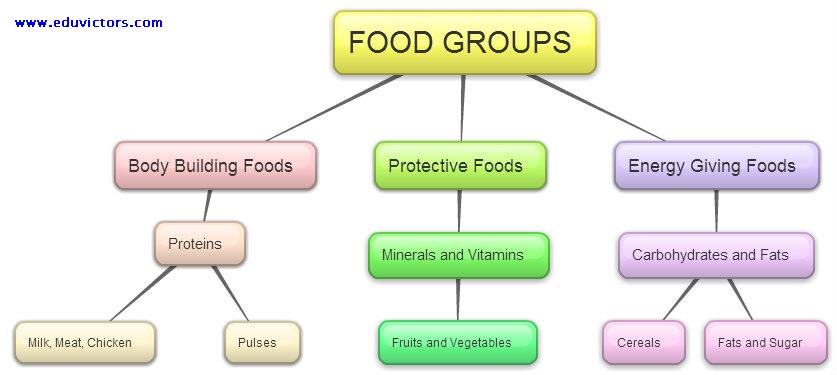
EVALUATION:
What is food?
What are the types of food?
What are the examples of types of food?
What are the classes of food?
ASSIGNMENT:
Give three examples of local food from your home town.
Bring samples of food to the class and classify them into the appropriate categories.
LESSON 17
TOPIC: CLASSES AND COMPOSITION OF FOOD
OBJECTIVE: At the end of the lesson, the students should be able to:
1. Give examples of carbohydrates and proteins.
2. State the functions of all the classes of food.
CONTENT:
1. CARBOHYDRATES: carbohydrates are composed of carbon, hydrogen and oxygen and the ratio of hydrogen to oxygen is 2:1. Carbohydrates are energy giving foods. Examples include rice, yam, millet, corn, bread, wheat.
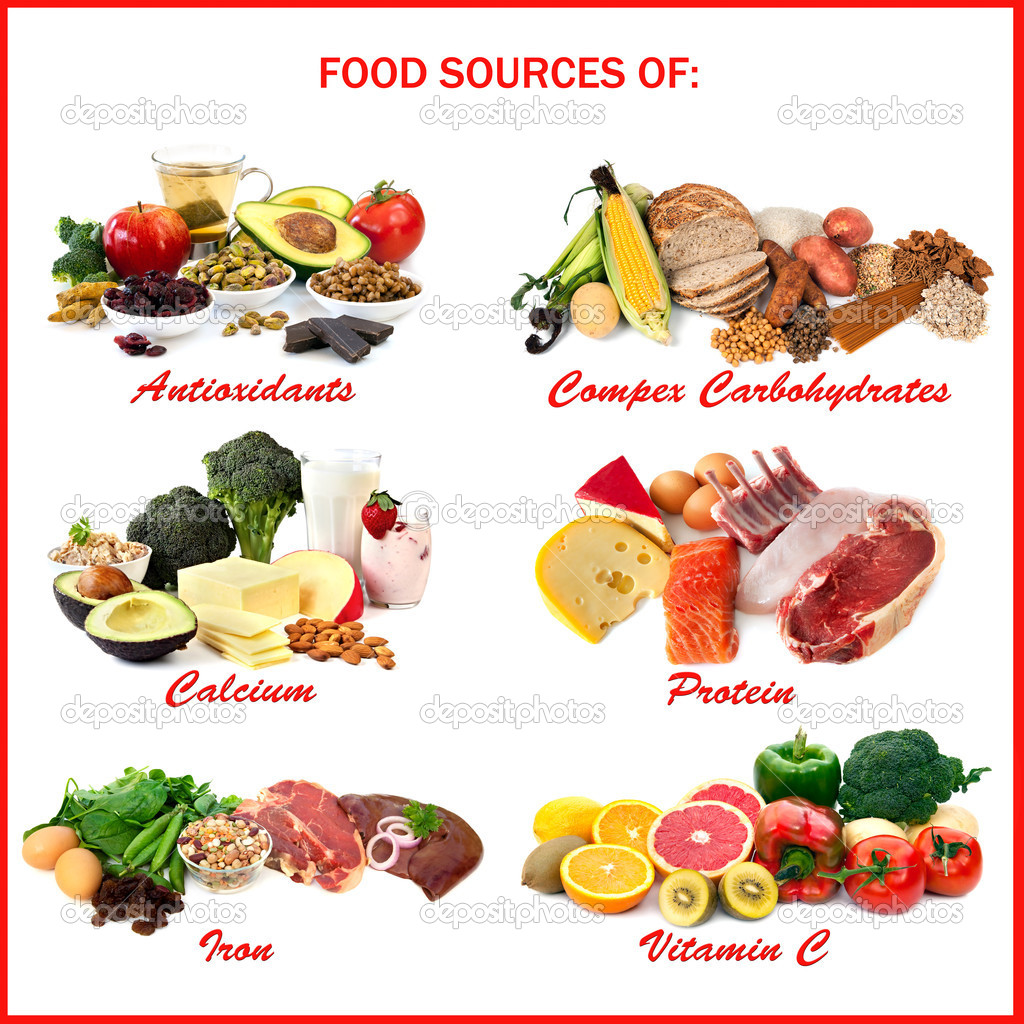
2. PROTEINS: proteins are composed of carbon, hydrogen, oxygen and nitrogen atoms. They may also contain sulphur and phosphorus. Proteins are used in body building, growth and repair of worn out cells. Examples include meat, fish, cheese, yoghurt, beans, eggs.
3. FATS AND OIL (LIPIDS): lipids are composed of carbon, hydrogen and oxygen atoms but the ratio of hydrogen to oxygen is more than that in carbohydrates. Fats are solid and oils are liquid at room temperature.
Fats and oils are energy giving foods. Examples are palm oil, groundnut oil, vegetable oil and margarine.
4. VITAMINS: vitamins vary in chemical composition from one to another. All vitamins are made by living organisms. Types of vitamins are:-
Vitamin---Properties Sources Function Effect of deficiency
A- Fat soluble Tomatoes, cod liver oil, liver, milk, palm oil, carrots, egg yolk, butter. Helps to bring about growth; necessary for good vision. Retards normal growth; causes poor night vision.
B1 - Water soluble Yeast, eggs, cereals, vegetables. Helps growth and respiration. Beri beri
B2 - Water soluble Milk, yeast, eggs Helps in respiration Anaemia Pellagra
C - Water soluble Fresh vegetables citrus fruits Helps in healing of wounds. In antibody formation. Maintenance of bone and teeth Scurvy
D - Fat soluble Eggs, liver, synthesized by skinning in sunlight Helps in calcification of bones and teeth. Rickets
E - Fat soluble Eggs, liver, green vegetables Concerned with reproductive processes and fat metabolism. Sterility
K - Fat soluble Green vegetables Assists blood clotting Blood clots very slowly.
EVALUATION:
What are the examples of carbohydrates and proteins?
What are the functions of all the classes of food?
ASSIGNMENT:
Give four examples of minerals.
Analyze the school weekly food menu and classify appropriately.
LESSON 18
TOPIC: CLASSES AND COMPOSITION OF FOOD
OBJECTIVE: At the end of the lesson, the students should be able to:
1. Give examples of mineral salts and their functions.
2. Outline the functions of water in the body.
CONTENT:
5. MINERAL SALTS: these are individual chemical substances which are required by the human body for good health. These minerals include:
(a) Potassium: plays a part in conduction of impulses by nerves.
(b) Calcium: constituent of bones and teeth.
(c) Sulphur: necessary for formation of hair, nails and some protein.
(d) Phosphorus: necessary for assimilation of food.
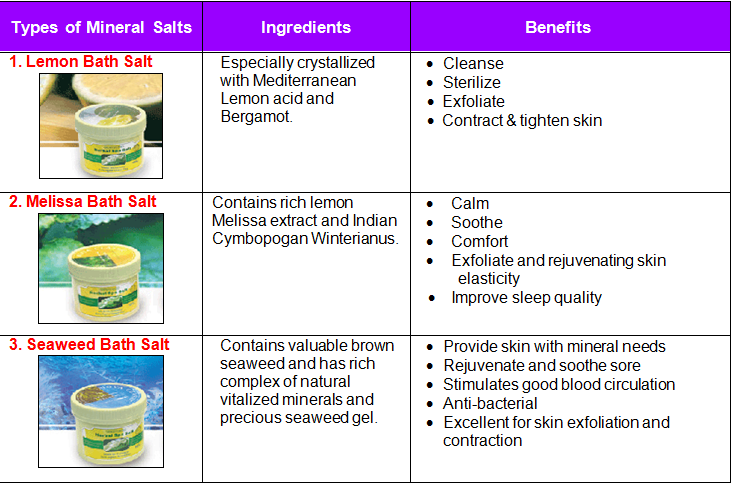
6. WATER: water is made up of hydrogen and oxygen. Water is a class of food because it is very important for body functioning and building. Water is necessary for digestion and absorption of food.
ADEQUATE DIET
An adequate diet is one that is sufficient in quantity of food nutrients (all classes of food) in the required amounts or proportions. An adequate diet is also called a balanced diet.
The idea of a balanced diet is that all nutrients should be present, and in amounts required by the body, not necessarily in equal amounts.
The reason why we should take an adequate or balanced diet is that each nutrient has its function. If any nutrient is undersupplied or absent from the diet, the body becomes malnourished and may develop deficiency disease.
EVALUATION:
What are the examples of mineral salts and their function?
What are the functions of water in the body?
ASSIGNMENT:
Plan an adequate breakfast, lunch and super meals for your family.
further studies
http://www.trans4mind.com/personal_deve ... OfFood.htm
practice test
http://www.sciencekids.co.nz/quizzes/food.html
TOPIC: FAMILY HEALTH (NUTRITION)

Content:
1. Food and adequate diet.
2. Type or composition of nutrition
3. Adequate diet
Food and Adequate Diet:
Food: Food is anything eaten to satisfy appetite and to meet physiological needs for growth, to maintain all body processes, and to supply energy to maintain body temperature and activity
Adequate/Balanced Diet: An adequate diet is that which is sufficient in quantity and food nutrients in the required amount/proportions or consists of a variety of foods in the right quantities and proportions to meet our needs.

Types of Food: This refers to the ways of grouping foods on various bases and purposes. Examples of food types are
i. Solid or liquid
ii. Local or imported
iii. Cereals, vegetables or fruits
iv. Eaten raw or cooked
Evaluation
1.Why is food important to you?
2. Define balance/adequate diet.
LESSON 15
Classes of Food Nutrients:
There are five main classes of nutrients found in food, namely carbohydrates, proteins, fat and oil, minerals salt and vitamins. Nutrient is a group of chemical compounds found in food .In an adequate diet, they become six including water.

Carbohydrates: These are mainly concerned with supplying us with energy rice, yam, maize, cassava, etc.
Proteins: -These are food nutrients mainly concerned with growth and repair of parts of the body e.g meat, fish, eggs, beans, groundnut, milk, etc.
Fats: They supply us with energy, palm oil, groundnut oil, butter, margarine, e.t.c. they supplied us energy.
Vitamins: These consist of fruits and green leafy vegetables – vitamins aid digestion and sound health.
Mineral salts : It helps us to digest our food and form the hard parts of our skeleton.
– onions, milk, tomatoes, dried fish, okra, olives e.t.c.

EVALUATION
1. List food items which would make up a balanced or adequate breakfast, lunch and supper.
2. Differentiate between a meal and a balanced diet.
ASSIGNMENT
In a tabular form, identify the food nutrients and examples of their food items.
READING ASSIGNMENT: Read Stan pages 47-50.
LESSON 16
TOPIC: FAMILY HEALTH (NUTRITION)
OBJECTIVE: At the end of the lesson, the students should be able to:
1. Define food.
2. Mention types of food.
3. Give examples of types of food.
4. Enumerate the classes of food.

CONTENT:
FOOD:
Food is a thing which when eaten and digested, can be used by the body to provide energy, or substances that help in body building and repair or in preservation of health.
TYPES OF FOOD
Food may be grouped into types according to whether they are:
(1) Solid or liquid
(2) Local or imported
(3) Cereals, vegetables or fruits
(4) Eaten raw or cooked
Solid Foods ......Liquid Foods
Yam ..................Milk
Rice ..................Cocoa drink ( such as bournvita or milo)
Bread ...............Fruit juices
beans
Local foods ........Imported foods
Beans ................Milk
Yam ...................Stock fish
Sweet potato ....Pasta
Guinea corn .......cheese
Cereals ....Vegetables .....Fruits
Oats .........Spinach ..........Oranges
Corn flakes Water leaf .....Pear
Rice crispies Bitter leaf .....Water melon
....................Lettuce .........apple
Foods eaten raw ........Foods eaten cooked
Lettuce .........................Yam
Pawpaw ........................Potato
Cucumber ......................Fish
Carrot ...........................Meat

CLASSES AND COMPOSITION OF FOOD
Foods are grouped into classes based on the:-
(1) Chemical composition of the food.
(2) Nutrient present in the food.
Accordingly foods are grouped into six classes namely:
(1) Carbohydrates
(2) Proteins
(3) Fats and oils (lipids)
(4) Vitamins
(5) Mineral salts
(6) Water

EVALUATION:
What is food?
What are the types of food?
What are the examples of types of food?
What are the classes of food?
ASSIGNMENT:
Give three examples of local food from your home town.
Bring samples of food to the class and classify them into the appropriate categories.
LESSON 17
TOPIC: CLASSES AND COMPOSITION OF FOOD
OBJECTIVE: At the end of the lesson, the students should be able to:
1. Give examples of carbohydrates and proteins.
2. State the functions of all the classes of food.
CONTENT:
1. CARBOHYDRATES: carbohydrates are composed of carbon, hydrogen and oxygen and the ratio of hydrogen to oxygen is 2:1. Carbohydrates are energy giving foods. Examples include rice, yam, millet, corn, bread, wheat.

2. PROTEINS: proteins are composed of carbon, hydrogen, oxygen and nitrogen atoms. They may also contain sulphur and phosphorus. Proteins are used in body building, growth and repair of worn out cells. Examples include meat, fish, cheese, yoghurt, beans, eggs.
3. FATS AND OIL (LIPIDS): lipids are composed of carbon, hydrogen and oxygen atoms but the ratio of hydrogen to oxygen is more than that in carbohydrates. Fats are solid and oils are liquid at room temperature.
Fats and oils are energy giving foods. Examples are palm oil, groundnut oil, vegetable oil and margarine.
4. VITAMINS: vitamins vary in chemical composition from one to another. All vitamins are made by living organisms. Types of vitamins are:-
Vitamin---Properties Sources Function Effect of deficiency
A- Fat soluble Tomatoes, cod liver oil, liver, milk, palm oil, carrots, egg yolk, butter. Helps to bring about growth; necessary for good vision. Retards normal growth; causes poor night vision.
B1 - Water soluble Yeast, eggs, cereals, vegetables. Helps growth and respiration. Beri beri
B2 - Water soluble Milk, yeast, eggs Helps in respiration Anaemia Pellagra
C - Water soluble Fresh vegetables citrus fruits Helps in healing of wounds. In antibody formation. Maintenance of bone and teeth Scurvy
D - Fat soluble Eggs, liver, synthesized by skinning in sunlight Helps in calcification of bones and teeth. Rickets
E - Fat soluble Eggs, liver, green vegetables Concerned with reproductive processes and fat metabolism. Sterility
K - Fat soluble Green vegetables Assists blood clotting Blood clots very slowly.
EVALUATION:
What are the examples of carbohydrates and proteins?
What are the functions of all the classes of food?
ASSIGNMENT:
Give four examples of minerals.
Analyze the school weekly food menu and classify appropriately.
LESSON 18
TOPIC: CLASSES AND COMPOSITION OF FOOD
OBJECTIVE: At the end of the lesson, the students should be able to:
1. Give examples of mineral salts and their functions.
2. Outline the functions of water in the body.
CONTENT:
5. MINERAL SALTS: these are individual chemical substances which are required by the human body for good health. These minerals include:
(a) Potassium: plays a part in conduction of impulses by nerves.
(b) Calcium: constituent of bones and teeth.
(c) Sulphur: necessary for formation of hair, nails and some protein.
(d) Phosphorus: necessary for assimilation of food.

6. WATER: water is made up of hydrogen and oxygen. Water is a class of food because it is very important for body functioning and building. Water is necessary for digestion and absorption of food.
ADEQUATE DIET
An adequate diet is one that is sufficient in quantity of food nutrients (all classes of food) in the required amounts or proportions. An adequate diet is also called a balanced diet.
The idea of a balanced diet is that all nutrients should be present, and in amounts required by the body, not necessarily in equal amounts.
The reason why we should take an adequate or balanced diet is that each nutrient has its function. If any nutrient is undersupplied or absent from the diet, the body becomes malnourished and may develop deficiency disease.
EVALUATION:
What are the examples of mineral salts and their function?
What are the functions of water in the body?
ASSIGNMENT:
Plan an adequate breakfast, lunch and super meals for your family.
further studies
http://www.trans4mind.com/personal_deve ... OfFood.htm
practice test
http://www.sciencekids.co.nz/quizzes/food.html
WEEK 5
LESSON 19
TOPIC: ENVIRONMENTAL CONSERVATION AND SAFETY 1 (MAINTAIN BALANCE)
CONTENT:
1. Source of earth energy.
2. Water cycle.

Source of earth energy:
The sun is the primary source of all forms of energy. The sun radiates direct heat and light energy to the earth.

PLANTS AS PRIMARY PRODUCERS
1. Plants get their energy from the light of the sun and used it to make food during the process of photosynthesis. This is the process whereby green plants manufacture their food in the presence of sunlight, carbon dioxide and water.
2. Herbivores and carnivores (animals that eat plants and flesh) eat various parts of the plants to get the energy stored in the plants for their life processes. They store some and lose some energy as heat.
3. As dead plants and animals decay, the chemicals in their bodies return to the earth. The mineral elements maybe absorbed by plants again. As this occurs, chemicals are cycled from living things to the non-living environment, reverting to the earth as elements.
EVALUATION
1. What is the source of all forms of energy?
2. What type of energy does sun radiates on earth?
3. The process of capturing light energy from the sun by plants is called --?
LESSON 20
Plants as Primary Producers
In a community all the populations are depending on each other. For instance, in a community living organisms made up of plant (grass), cattle and man. There is producer, primary consumer and secondary consumer.
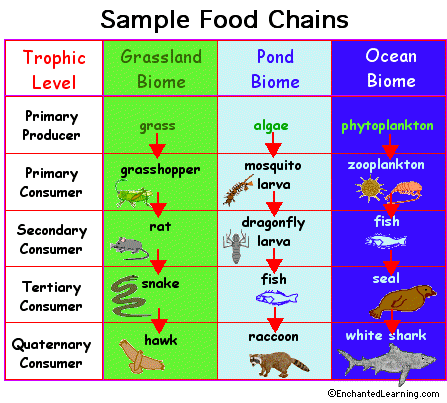
This is a simple food chain. Here, plant is seen as the primary producer in this ecosystem.
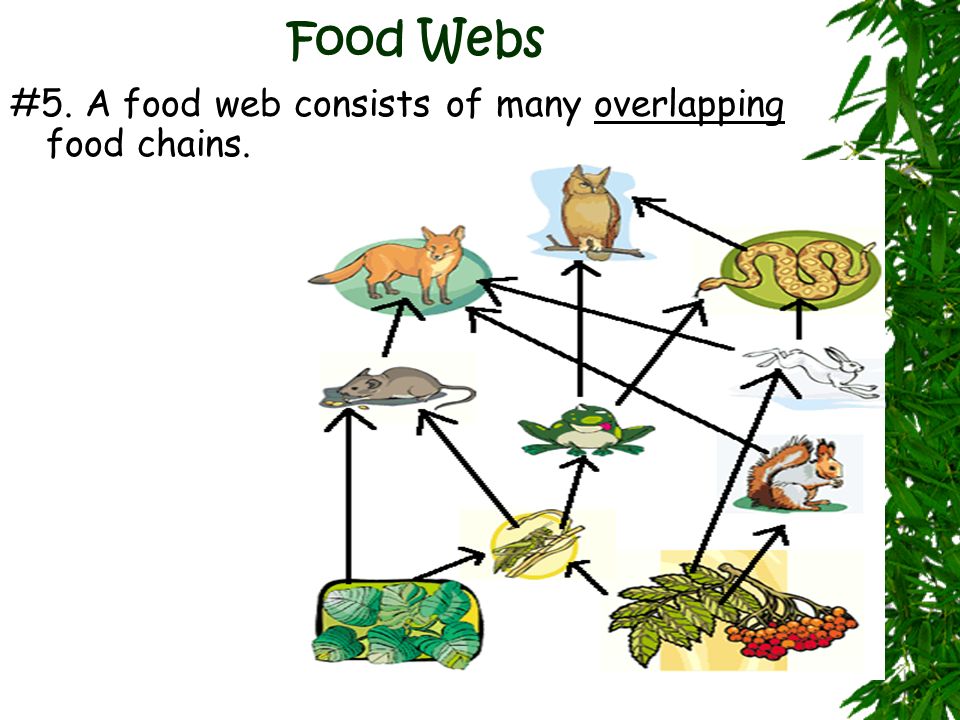
EVALUATION
Explain why plants are the primary producers.
ASSIGNMENT
1. Define the term food web.
2. With the aid of a diagram, describe a food web.
READING ASSIGNMENT: Read STAN pages 51-52
LESSON 21
TOPIC: ENVIRONMENTAL CONSERVATION AND SAFETY 1
OBJECTIVE: At the end of the lesson, the students should be able to:
1. Define biosphere.
2. Give the name of the energy from the sun.
3. State the functions of the radiant energy.
4. Describe how the sun provides energy for the earth.
CONTENT:
MAINTAINING BALANCE:
The part of the Earth in which living things live is called the biosphere. The living and the non living things of the Earth constantly interact. Living things on earth depend on each other. Maintaining a balance of resources in the environment is important.
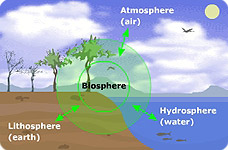
THE SUN AS THE SOURCE OF EARTH'S ENERGY
The Earth has no energy of her own. The sun is the principal source of the energy that drives all life on earth. The sun gives out a large amount of energy known as radiant energy includes visible light and heat. This energy of the sun keeps the earth warm enough to be inhabited by living things, it also keeps living things warm.
HOW THE SUN PROVIDES ENERGY FOR THE EARTH
Green plants capture the sunlight energy and use it to convert carbon di oxide and water into sugar in the process known as photosynthesis. This sugar is used to make carbohydrates, proteins and lipids.
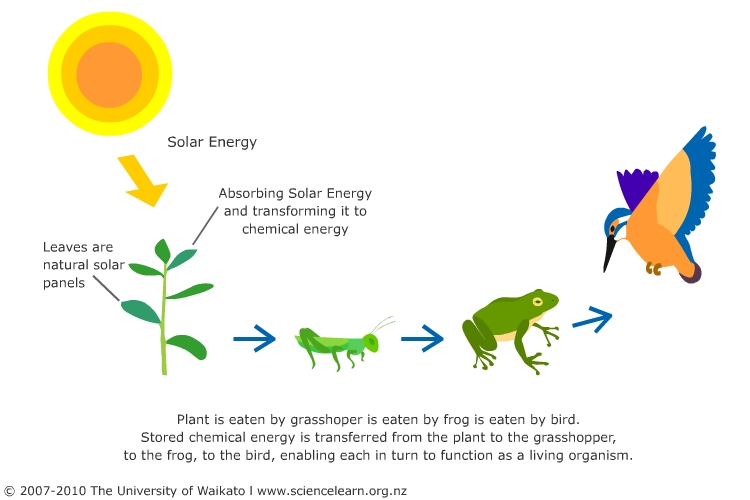
Herbivores (animals that eat plants) eat the plants in order to obtain energy stored by the plants. In their leaves, fruits, stems and other parts. Herbivores use the energy in the plant materials they eat for their own life processes. They store some and lose some energy as heat.
watch video
https://youtu.be/OlKfpaSOuBM
EVALUATION:
What is biosphere?
What is the name of the energy from the sun?
What are the functions of the radiant energy?
How does the sun provide energy for the earth?
ASSIGNMENT:
Name four natural conservation centres in Nigeria.
LESSON 22
TOPIC: HOW THE SUN PROVIDES ENERGY FOR THE EARTH (CONTD)
OBJECTIVE: At the end of the lesson, the students should be able to:
1. Define carnivores.
2. Explain what happens to plants and animals when they die.
CONTENT:
Carnivores (animals that eat flesh) feed on herbivores and in turn obtain energy from the flesh they eat, which they use for various purposes.
Eventually, plants and animals die and they decay. As they decay, the chemicals in their bodies return to the Earth. The mineral elements may be absorbed by the plants again.
As this happens, the chemicals are cycled from living things to the non living environment and back to living things.
EVALUATION:
What are carnivores?
What happens to plants and animals when they die?
ASSIGNMENT:
Differentiate between biosphere and atmosphere.
Discuss how energy can be conserved at home.
LESSON 23
TOPIC: WATER CYCLE
OBJECTIVE: At the end of the lesson, the students should be able to:
1. Define water cycle.
2. Mention the sources of water vapour.
3. Explain what happens to the water vapour in the clouds.

CONTENT:
As the sea breeze blows from the sea to the land, it carries a lot of water vapour with it. Other sources of water vapour which enters the clouds include:
(1) Water lost from the land by evaporation.
(2) Water lost by plants through transpiration and excretion.
The water vapour in the clouds, condense and fall as rain. As rain falls, a part of it soaks into the ground and infiltrates downwards to the water table.
Some of it called runoff water, flows along the surface of the ground into streams, rivers and lakes. The water in the streams, rivers and soil eventually flows into the sea (ocean). The events described above take place all the time and constitute the water cycle.
Water cycle is therefore defined as the continuous movement of water to the atmosphere from the Earth and from the atmosphere to the Earth.
In summary, the atmosphere receives water through:
(1) Evaporation from oceans and land.
(2) Transpiration from plants.
(3) Breathing or respiration by plants and animals
While the land receives water through:
(1) Rainfall or precipitation.
(2) Infiltration and percolation.
EVALUATION:
What is water cycle?
What are the sources of water vapour?
What happens to water vapour in the clouds?
ASSIGNMENT:
Draw the water cycle.
Recount your experience of witnessing different pools of water drying up, along the roads and streets. What happened to the dried water?
practice test
http://www.softschools.com/quizzes/scie ... iz316.html
TOPIC: ENVIRONMENTAL CONSERVATION AND SAFETY 1 (MAINTAIN BALANCE)
CONTENT:
1. Source of earth energy.
2. Water cycle.

Source of earth energy:
The sun is the primary source of all forms of energy. The sun radiates direct heat and light energy to the earth.

PLANTS AS PRIMARY PRODUCERS
1. Plants get their energy from the light of the sun and used it to make food during the process of photosynthesis. This is the process whereby green plants manufacture their food in the presence of sunlight, carbon dioxide and water.
2. Herbivores and carnivores (animals that eat plants and flesh) eat various parts of the plants to get the energy stored in the plants for their life processes. They store some and lose some energy as heat.
3. As dead plants and animals decay, the chemicals in their bodies return to the earth. The mineral elements maybe absorbed by plants again. As this occurs, chemicals are cycled from living things to the non-living environment, reverting to the earth as elements.
EVALUATION
1. What is the source of all forms of energy?
2. What type of energy does sun radiates on earth?
3. The process of capturing light energy from the sun by plants is called --?
LESSON 20
Plants as Primary Producers
In a community all the populations are depending on each other. For instance, in a community living organisms made up of plant (grass), cattle and man. There is producer, primary consumer and secondary consumer.

This is a simple food chain. Here, plant is seen as the primary producer in this ecosystem.

EVALUATION
Explain why plants are the primary producers.
ASSIGNMENT
1. Define the term food web.
2. With the aid of a diagram, describe a food web.
READING ASSIGNMENT: Read STAN pages 51-52
LESSON 21
TOPIC: ENVIRONMENTAL CONSERVATION AND SAFETY 1
OBJECTIVE: At the end of the lesson, the students should be able to:
1. Define biosphere.
2. Give the name of the energy from the sun.
3. State the functions of the radiant energy.
4. Describe how the sun provides energy for the earth.
CONTENT:
MAINTAINING BALANCE:
The part of the Earth in which living things live is called the biosphere. The living and the non living things of the Earth constantly interact. Living things on earth depend on each other. Maintaining a balance of resources in the environment is important.

THE SUN AS THE SOURCE OF EARTH'S ENERGY
The Earth has no energy of her own. The sun is the principal source of the energy that drives all life on earth. The sun gives out a large amount of energy known as radiant energy includes visible light and heat. This energy of the sun keeps the earth warm enough to be inhabited by living things, it also keeps living things warm.
HOW THE SUN PROVIDES ENERGY FOR THE EARTH
Green plants capture the sunlight energy and use it to convert carbon di oxide and water into sugar in the process known as photosynthesis. This sugar is used to make carbohydrates, proteins and lipids.

Herbivores (animals that eat plants) eat the plants in order to obtain energy stored by the plants. In their leaves, fruits, stems and other parts. Herbivores use the energy in the plant materials they eat for their own life processes. They store some and lose some energy as heat.
watch video
https://youtu.be/OlKfpaSOuBM
EVALUATION:
What is biosphere?
What is the name of the energy from the sun?
What are the functions of the radiant energy?
How does the sun provide energy for the earth?
ASSIGNMENT:
Name four natural conservation centres in Nigeria.
LESSON 22
TOPIC: HOW THE SUN PROVIDES ENERGY FOR THE EARTH (CONTD)
OBJECTIVE: At the end of the lesson, the students should be able to:
1. Define carnivores.
2. Explain what happens to plants and animals when they die.
CONTENT:
Carnivores (animals that eat flesh) feed on herbivores and in turn obtain energy from the flesh they eat, which they use for various purposes.
Eventually, plants and animals die and they decay. As they decay, the chemicals in their bodies return to the Earth. The mineral elements may be absorbed by the plants again.
As this happens, the chemicals are cycled from living things to the non living environment and back to living things.
EVALUATION:
What are carnivores?
What happens to plants and animals when they die?
ASSIGNMENT:
Differentiate between biosphere and atmosphere.
Discuss how energy can be conserved at home.
LESSON 23
TOPIC: WATER CYCLE
OBJECTIVE: At the end of the lesson, the students should be able to:
1. Define water cycle.
2. Mention the sources of water vapour.
3. Explain what happens to the water vapour in the clouds.

CONTENT:
As the sea breeze blows from the sea to the land, it carries a lot of water vapour with it. Other sources of water vapour which enters the clouds include:
(1) Water lost from the land by evaporation.
(2) Water lost by plants through transpiration and excretion.
The water vapour in the clouds, condense and fall as rain. As rain falls, a part of it soaks into the ground and infiltrates downwards to the water table.
Some of it called runoff water, flows along the surface of the ground into streams, rivers and lakes. The water in the streams, rivers and soil eventually flows into the sea (ocean). The events described above take place all the time and constitute the water cycle.
Water cycle is therefore defined as the continuous movement of water to the atmosphere from the Earth and from the atmosphere to the Earth.
In summary, the atmosphere receives water through:
(1) Evaporation from oceans and land.
(2) Transpiration from plants.
(3) Breathing or respiration by plants and animals
While the land receives water through:
(1) Rainfall or precipitation.
(2) Infiltration and percolation.
EVALUATION:
What is water cycle?
What are the sources of water vapour?
What happens to water vapour in the clouds?
ASSIGNMENT:
Draw the water cycle.
Recount your experience of witnessing different pools of water drying up, along the roads and streets. What happened to the dried water?
practice test
http://www.softschools.com/quizzes/scie ... iz316.html
WEEK 6
LESSON 24
TOPIC: CARBON, WATER AND NITROGEN CYCLES
CONTENT:
1. Conservation of energy, water and wildlife
2. Explanation on how carbon, water and nitrogen are maintained in nature
3. Significance of maintaining balance natural resources
CONSERVATION OF ENERGY
This means careful use of energy. The energy that comes from the sun is converted into a form in which it can be stored in green plants and which later is fed upon by other living things. Energy cannot be created nor destroyed but can be transformed from one form to another.
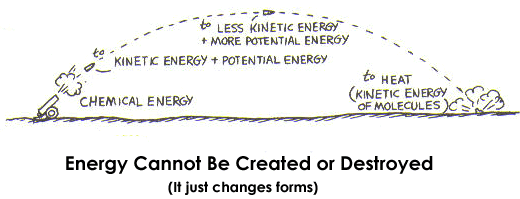

CONSERVATION OF WATER
Water cycle provides a system for conserving water in nature. Water used for domestic washing and other purposes always find their ways to the atmosphere. It evaporates in the heat of the sun to form water vapour (evaporation). The water then falls back to the earth as rain.
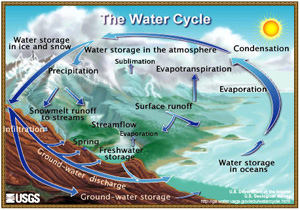
CONSERVATION OF WILDLIFE

Ecosystem is made up of living organisms and their non-living environment. Wildlife plays an important role in maintaining the balance of various ecosystems. Their existence is threatened by
i. Destroying and reducing their living space by burning, damming rivers and drawing swamps.
ii. Polluting their environments
iii. Indiscriminate hunting for their products
iv. Over fishing for food.
The importance of maintaining balance of resources in the environment is to enable human beings to meet up with all essential needs. The consequence of not maintaining balance will result to death of all living.
CARBON CYCLE
Carbon, used by all living organisms continuously circulates in Earth’s ecosystem. In the atmosphere it exists as carbon dioxide ( carbon iv oxide) a colourless, and odourless gas. Plants absorb carbon dioxide in the process of photosynthesis. Animals acquire the carbon stored in plants tissues when they eat and exhale carbon dioxide as a by product of metabolism. Surface bodies of water, especially oceans absorb vast amounts of atmospheric carbon dioxide. Some carbon is removed from circulation as deposits of coal, oil, natural gas and limestone. The burning of fossils fuels adds additional carbon dioxide to the atmosphere

Water Cycle
Content
The source of all water is the sea. Sun heat the sea and some of the sea water changes into vapour through the process called evaporation. . The continuous movement of water from the land, rivers and oceans to the atmosphere and from the atmosphere to the land, rivers and oceans is known as the water cycle.
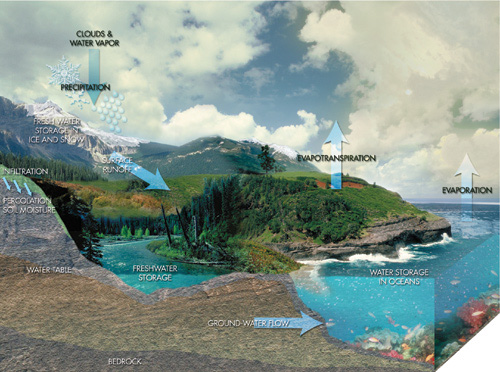
EVALUATION
1. What is the source of all water?
2. When water evaporates it turns to what?
3. What do you understand by wildlife conservation?
4. Why is water conservation important?
LESSON 25
NITROGEN CYCLE
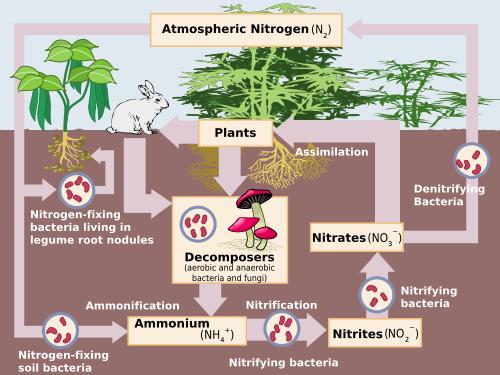
Nitrogen is an essential element. The earth atmosphere contains 78% of nitrogen gas. Nitrogen is essential for making proteins and chlorophyll by plants.
Nitrogen Fixation
The chemical nature of nitrogen gas (with triple bonds), makes it unusable in its elemental form. Thus, atmospheric nitrogen is fixed as ammonium by means of lightening (natural fixation), microbes (biological fixation) and industrial fixation (under high pressure and temperature). Nitrogen is also converted into nitrogen oxides (NOx) by burning fossil fuels.
Nitrogen Assimilation
Soil nitrogen is contributed by application of plant manures and fertilizers. Nitrogen from the soil reservoir is absorbed by some species of plants in the chemical form of ammonium ions or nitrate ions. Animals, on the other hand, derived their nitrogen requirements by consumption of plants and other organic matter.
Nitrogen Mineralization
Also known a ammonification, organic form of nitrogen from the animal wastes, death and decayed living organisms is converted into inorganic form. Over here, decomposers (bacteria and fungi) act on the decayed organic matter containing nitrogen and convert it into ammonium (NH4+).
Nitrification
By the process of nitrification, the ammonium NH4+ is converted into nitrates NO3- that are assimilated by plants. First, ammonium is oxidized into nitrites (NO2-), which are further oxidized to form nitrates (NO3-). In this nitrogen cycle step, oxygen is essential for conversion of the nitrates by nitrifying bacteria (mostly soil bacteria).
Denitrification
Denitrification is the process, wherein nitrates are converted to the molecular nitrogen form (N2) in an anaerobic condition by the process of reduction. Heterotrophic bacteria and autotrophic denitrifiers are responsible for carrying out this nitrogen cycle step. This is the end of nitrogen cycle, in which the molecular nitrogen is returned back to the atmosphere and soil.
WAYS OF NITROGEN CYCLE
1. Nitrogen fixation- This is done by nitrogen bacteria called Azotobacter, clostridium and Rhodo spirillum living in the soil are able to produce nitrates from free nitrogen in soil.
2. Nitrogen fixing bacteria (symbiotic bacteria):- Species of Rhizobium associate with roots of leguminous plants e.g. groundnut, beans and crotalaria to build up nitrates which the root of the plant absorbs to from protein.
3. Blue green algae: are capable of fixing the atmospheric nitrogen into nitrates.
4. Thunder storms: During thunderstorms, the lightning produced causes the atmospheric to combine with oxygen to from nitrogen (ii) oxide (No)N2 + O2 2NO
5. Decay: - during decay of plants and animals, protein is decomposed by putrefying bacteria into ammonia. Nitrifying bacteria oxidize ammonia to nitrites. And another nitrifying bacteria (Nitrobacteria) convert’s nitrites to nitrates.
The process of converting ammonia to nitrates is known as nitrification.
EVALUATION
1. State the various process involved in carbon cycle
2. What is the percentage of carbon (iv) oxide present in atmosphere?
3. Define nitrification
4. Write the equation involved in photosynthesis
ASSIGNMENT
1. Draw a well labeled diagram of water cycle
READ STAN PAGES 54-58
LESSON 26
TOPIC: CARBON CYCLE
OBJECTIVE: At the end of the lesson, the students should be able to:
1. Describe carbon cycle.
2. Mention the processes that release carbon(IV)oxide into the atmosphere.
3. Enumerate the process of removing CO2 from the atmosphere.
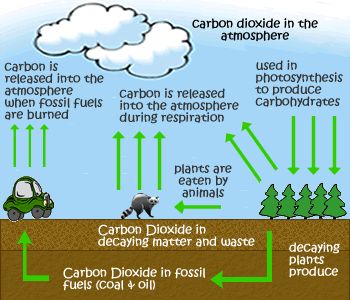
CONTENT:
Carbon is being continuously circulated in nature by a series of changes known as the carbon cycle. Atmospheric Carbon (IV) oxide forms the vital link among the various carbon compounds in the cycle. The volume of Carbon (IV) oxide in the atmosphere remains constant. This is achieved through a natural balance between its rate of formation and removal from the atmosphere.
Carbon (IV) oxide is released into the atmosphere through the following processes:
(1) Burning of all substances containing carbon e.g. petrol, coal, wood.
(2) Fermentation of sugars.
(3) The decay of all organic materials.
Carbon (IV) oxide is removed from the atmosphere by:
(1) Photosynthesis; during this process plants use carbon (iv) oxide, water and solar energy to produce carbohydrate.
(2) Dissolving in rain water and natural water bodies.
watch video
https://www.youtube.com/watch?v=mrf-cHy ... re=related
EVALUATION:
What is carbon cycle?
What processes release carbon (IV) oxide into the atmosphere?
What are the processes of removing CO2 from the atmosphere?
ASSIGNMENT:
1. Name two allotropes of carbon.
2. Mention the usefulness of each of the allotropes
3. Discuss the green house effect.
practice test
http://www.softschools.com/quizzes/scie ... iz397.html
http://www.proprofs.com/quiz-school/qui ... &quesnum=1
LESSON 27
TOPIC: NITROGEN CYCLE
OBJECTIVE: At the end of the lesson, the students should be able to:
1. Describe nitrogen cycle.
2. Mention the stages in which atmospheric nitrogen is converted to soil nitrogen and back to free nitrogen.

CONTENT:
These are the various processes by which nitrogen which is present in the atmosphere is converted into various nitrogen compounds, for animal and plant use, and finally returned to the atmosphere as free gaseous nitrogen.
http://www.physicalgeography.net/fundamentals/9s.html
The stage in which atmospheric nitrogen is converted into soil nitrogen and back to free nitrogen occurs in the following ways:
1. Oxidation of atmospheric nitrogen.
2. Action of nitrogen-fixing bacteria.
3. Decay of organic matter.
4. Denitrification.
EVALUATION:
What is nitrogen cycle?
What are the stages in which atmospheric nitrogen is converted to soil nitrogen and back to free nitrogen?
ASSIGNMENT:
What is the function of nitrogen in proteins?
practice test
http://www.proprofs.com/quiz-school/qui ... &quesnum=1
LESSON 28
TOPIC: NITROGEN CYCLE
OBJECTIVE: At the end of the lesson, the students should be able to:
1. Define nitrogen fixing bacteria.
2. Give examples of nitrifying bacteria.
3. Explain denitrification.
CONTENT:
Nitrogen fixing bacteria are soil micro organisms that are active in replenishing soil trioxonitrate (V) e.g. rhizobium. Examples of nitrifying bacteria are nitrosomonas and nitrobacter.
Denitrification is the conversion of trioxonitrate (V) in the soil to gaseous nitrogen by denitrifying bacteria.
http://www.tropicalpermaculture.com/nit ... teria.html
NITROGEN CYCLE
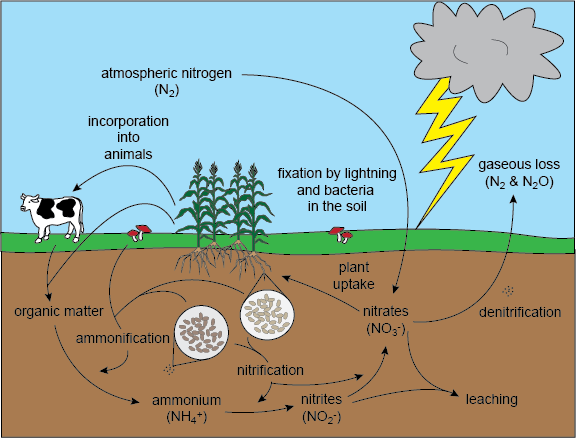
EVALUATION:
What is nitrogen fixing bacteria?
What are the examples of nitrifying bacteria?
What is denitrification?
ASSIGNMENT:
Write a short note on animal protein.
practice test
http://www.proprofs.com/quiz-school/qui ... &quesnum=1
TOPIC: CARBON, WATER AND NITROGEN CYCLES
CONTENT:
1. Conservation of energy, water and wildlife
2. Explanation on how carbon, water and nitrogen are maintained in nature
3. Significance of maintaining balance natural resources
CONSERVATION OF ENERGY
This means careful use of energy. The energy that comes from the sun is converted into a form in which it can be stored in green plants and which later is fed upon by other living things. Energy cannot be created nor destroyed but can be transformed from one form to another.


CONSERVATION OF WATER
Water cycle provides a system for conserving water in nature. Water used for domestic washing and other purposes always find their ways to the atmosphere. It evaporates in the heat of the sun to form water vapour (evaporation). The water then falls back to the earth as rain.

CONSERVATION OF WILDLIFE

Ecosystem is made up of living organisms and their non-living environment. Wildlife plays an important role in maintaining the balance of various ecosystems. Their existence is threatened by
i. Destroying and reducing their living space by burning, damming rivers and drawing swamps.
ii. Polluting their environments
iii. Indiscriminate hunting for their products
iv. Over fishing for food.
The importance of maintaining balance of resources in the environment is to enable human beings to meet up with all essential needs. The consequence of not maintaining balance will result to death of all living.
CARBON CYCLE
Carbon, used by all living organisms continuously circulates in Earth’s ecosystem. In the atmosphere it exists as carbon dioxide ( carbon iv oxide) a colourless, and odourless gas. Plants absorb carbon dioxide in the process of photosynthesis. Animals acquire the carbon stored in plants tissues when they eat and exhale carbon dioxide as a by product of metabolism. Surface bodies of water, especially oceans absorb vast amounts of atmospheric carbon dioxide. Some carbon is removed from circulation as deposits of coal, oil, natural gas and limestone. The burning of fossils fuels adds additional carbon dioxide to the atmosphere

Water Cycle
Content
The source of all water is the sea. Sun heat the sea and some of the sea water changes into vapour through the process called evaporation. . The continuous movement of water from the land, rivers and oceans to the atmosphere and from the atmosphere to the land, rivers and oceans is known as the water cycle.

EVALUATION
1. What is the source of all water?
2. When water evaporates it turns to what?
3. What do you understand by wildlife conservation?
4. Why is water conservation important?
LESSON 25
NITROGEN CYCLE

Nitrogen is an essential element. The earth atmosphere contains 78% of nitrogen gas. Nitrogen is essential for making proteins and chlorophyll by plants.
Nitrogen Fixation
The chemical nature of nitrogen gas (with triple bonds), makes it unusable in its elemental form. Thus, atmospheric nitrogen is fixed as ammonium by means of lightening (natural fixation), microbes (biological fixation) and industrial fixation (under high pressure and temperature). Nitrogen is also converted into nitrogen oxides (NOx) by burning fossil fuels.
Nitrogen Assimilation
Soil nitrogen is contributed by application of plant manures and fertilizers. Nitrogen from the soil reservoir is absorbed by some species of plants in the chemical form of ammonium ions or nitrate ions. Animals, on the other hand, derived their nitrogen requirements by consumption of plants and other organic matter.
Nitrogen Mineralization
Also known a ammonification, organic form of nitrogen from the animal wastes, death and decayed living organisms is converted into inorganic form. Over here, decomposers (bacteria and fungi) act on the decayed organic matter containing nitrogen and convert it into ammonium (NH4+).
Nitrification
By the process of nitrification, the ammonium NH4+ is converted into nitrates NO3- that are assimilated by plants. First, ammonium is oxidized into nitrites (NO2-), which are further oxidized to form nitrates (NO3-). In this nitrogen cycle step, oxygen is essential for conversion of the nitrates by nitrifying bacteria (mostly soil bacteria).
Denitrification
Denitrification is the process, wherein nitrates are converted to the molecular nitrogen form (N2) in an anaerobic condition by the process of reduction. Heterotrophic bacteria and autotrophic denitrifiers are responsible for carrying out this nitrogen cycle step. This is the end of nitrogen cycle, in which the molecular nitrogen is returned back to the atmosphere and soil.
WAYS OF NITROGEN CYCLE
1. Nitrogen fixation- This is done by nitrogen bacteria called Azotobacter, clostridium and Rhodo spirillum living in the soil are able to produce nitrates from free nitrogen in soil.
2. Nitrogen fixing bacteria (symbiotic bacteria):- Species of Rhizobium associate with roots of leguminous plants e.g. groundnut, beans and crotalaria to build up nitrates which the root of the plant absorbs to from protein.
3. Blue green algae: are capable of fixing the atmospheric nitrogen into nitrates.
4. Thunder storms: During thunderstorms, the lightning produced causes the atmospheric to combine with oxygen to from nitrogen (ii) oxide (No)N2 + O2 2NO
5. Decay: - during decay of plants and animals, protein is decomposed by putrefying bacteria into ammonia. Nitrifying bacteria oxidize ammonia to nitrites. And another nitrifying bacteria (Nitrobacteria) convert’s nitrites to nitrates.
The process of converting ammonia to nitrates is known as nitrification.
EVALUATION
1. State the various process involved in carbon cycle
2. What is the percentage of carbon (iv) oxide present in atmosphere?
3. Define nitrification
4. Write the equation involved in photosynthesis
ASSIGNMENT
1. Draw a well labeled diagram of water cycle
READ STAN PAGES 54-58
LESSON 26
TOPIC: CARBON CYCLE
OBJECTIVE: At the end of the lesson, the students should be able to:
1. Describe carbon cycle.
2. Mention the processes that release carbon(IV)oxide into the atmosphere.
3. Enumerate the process of removing CO2 from the atmosphere.

CONTENT:
Carbon is being continuously circulated in nature by a series of changes known as the carbon cycle. Atmospheric Carbon (IV) oxide forms the vital link among the various carbon compounds in the cycle. The volume of Carbon (IV) oxide in the atmosphere remains constant. This is achieved through a natural balance between its rate of formation and removal from the atmosphere.
Carbon (IV) oxide is released into the atmosphere through the following processes:
(1) Burning of all substances containing carbon e.g. petrol, coal, wood.
(2) Fermentation of sugars.
(3) The decay of all organic materials.
Carbon (IV) oxide is removed from the atmosphere by:
(1) Photosynthesis; during this process plants use carbon (iv) oxide, water and solar energy to produce carbohydrate.
(2) Dissolving in rain water and natural water bodies.
watch video
https://www.youtube.com/watch?v=mrf-cHy ... re=related
EVALUATION:
What is carbon cycle?
What processes release carbon (IV) oxide into the atmosphere?
What are the processes of removing CO2 from the atmosphere?
ASSIGNMENT:
1. Name two allotropes of carbon.
2. Mention the usefulness of each of the allotropes
3. Discuss the green house effect.
practice test
http://www.softschools.com/quizzes/scie ... iz397.html
http://www.proprofs.com/quiz-school/qui ... &quesnum=1
LESSON 27
TOPIC: NITROGEN CYCLE
OBJECTIVE: At the end of the lesson, the students should be able to:
1. Describe nitrogen cycle.
2. Mention the stages in which atmospheric nitrogen is converted to soil nitrogen and back to free nitrogen.

CONTENT:
These are the various processes by which nitrogen which is present in the atmosphere is converted into various nitrogen compounds, for animal and plant use, and finally returned to the atmosphere as free gaseous nitrogen.
http://www.physicalgeography.net/fundamentals/9s.html
The stage in which atmospheric nitrogen is converted into soil nitrogen and back to free nitrogen occurs in the following ways:
1. Oxidation of atmospheric nitrogen.
2. Action of nitrogen-fixing bacteria.
3. Decay of organic matter.
4. Denitrification.
EVALUATION:
What is nitrogen cycle?
What are the stages in which atmospheric nitrogen is converted to soil nitrogen and back to free nitrogen?
ASSIGNMENT:
What is the function of nitrogen in proteins?
practice test
http://www.proprofs.com/quiz-school/qui ... &quesnum=1
LESSON 28
TOPIC: NITROGEN CYCLE
OBJECTIVE: At the end of the lesson, the students should be able to:
1. Define nitrogen fixing bacteria.
2. Give examples of nitrifying bacteria.
3. Explain denitrification.
CONTENT:
Nitrogen fixing bacteria are soil micro organisms that are active in replenishing soil trioxonitrate (V) e.g. rhizobium. Examples of nitrifying bacteria are nitrosomonas and nitrobacter.
Denitrification is the conversion of trioxonitrate (V) in the soil to gaseous nitrogen by denitrifying bacteria.
http://www.tropicalpermaculture.com/nit ... teria.html
NITROGEN CYCLE

EVALUATION:
What is nitrogen fixing bacteria?
What are the examples of nitrifying bacteria?
What is denitrification?
ASSIGNMENT:
Write a short note on animal protein.
practice test
http://www.proprofs.com/quiz-school/qui ... &quesnum=1
WEEK 7
LESSON 29
TOPIC: ENVIRONMENTAL CONSERVATION AND SAFETY (SANITATION)
CONTENT: Definition of conservation
Types of human activities
Effects of human activities on ecosystem.
Conservation is defined as the control exploitation, planned or judicious use of natural resources to ensure their continuous availability and to preserve the quality or original nature of the environment. It can also be defined as the preservation of natural resources from loss waste or exploitation.
TYPES OF HUMAN ACTIVITIES
Some human activities on the environment include:
i. Farming
ii. Construction of roads and houses
iii. Use of transportation
iv. Construction of industries
v. Disposal of refuse, sewage, industrial effluent and
vi. Industrialization
vii, Mining
One important way of improving our environment is by maintaining a high level of sanitation. Sanitation is the removal of waste of all kinds from the home and its immediate surroundings. These include refuse which means dry waste and sewage which is the liquid wastes.
Effects of human activities on the ecosystem

1. Human activities have diverse effects on the ecosystem.
2. Farming causes soil erosion. Many animals are forced to migrate from their natural environment and become extinct.
3. Construction of roads and houses results in the loss of plants and animal species.
4. During the construction of industries, forests are destroyed, animals are killed, and it affects and alters the plants and animals species of the ecosystem.
5. Disposal of refuse, sewage, industrial effluent and waste causes pollution.
EVALUATION
Explain the effects of road construction and farming on ecosystem.
List all the types of human activities.
List three human activities that affect the environment.
Assignment
State the effects of human activities on the environment.
Reading assignment
Read Stan pages 67-72.
LESSON 30
TOPIC: ENVIRONMENTAL CONSERVATION AND SAFETY 2 (SANITATION)
OBJECTIVE: At the end of the lesson, the students should be able to:
1. Mention the types of human activities that affect environmental balance.
2. Explain ways of disposing refuse.
3. Define sewage water.
CONTENT:
Types of human activities that affect environmental balance:
There is a balance in nature. Many human activities affect environmental balance.
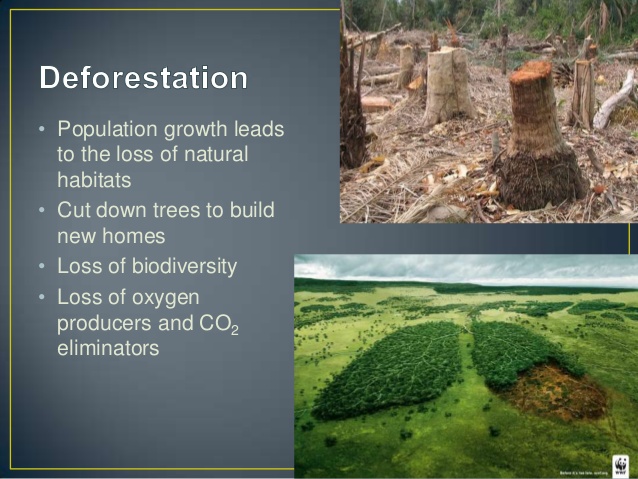
Human activities are comprised of many things which can destroy as well as endanger the environment and nature surrounding us. They are: coal mining (fossil extraction), factories, vehicles etc. They can pollute our environment and can destroy the nature and the animals.
They can also improve things.
Create fertile land where none existed for instance.
Human activities that damage the environment:
Burning fossil fuel
cutting trees
polluting water
Driving Cars
For example, global warming is the result of us humans not being considerate enough to care about what happens to all that deadly gas we emit into the environment.
Some others are
Pollution
Mass Manufacture
Deforestation
Introduction of exotic species to new environments
Overfishing
Specific human activities and the way they affect environmental balance are:
(1) Farming:
Farming affects environmental balance because when vegetation is cleared from the surface of the soil before cultivation is done. Clearing of vegetation exposes the soil to soil erosion by rain water. Mechanized cultivation of the soil for crop planting promotes wind erosion of soil, and dust pollution of the atmosphere.
A part of fertilizer applied to farm is washed out by surface floods into streams and rivers, thereby pollution the streams and rivers.
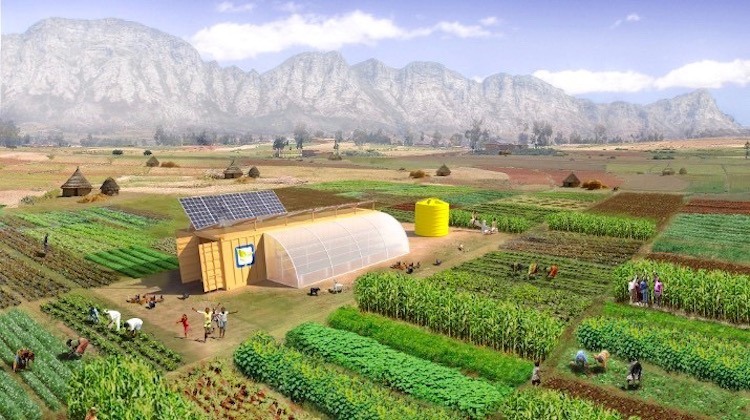
(2) Sewage Disposal:
Sewage is waste water together with waste materials in the water. It includes waste water from the toilet, from the bathroom and from the kitchen.
In a modern home, a water closet (WC) toilet is provided. Waste water from the kitchen and bathroom are also channeled into soak away pits. A good sewage system helps us to remain healthy by preventing the spread of disease germs.
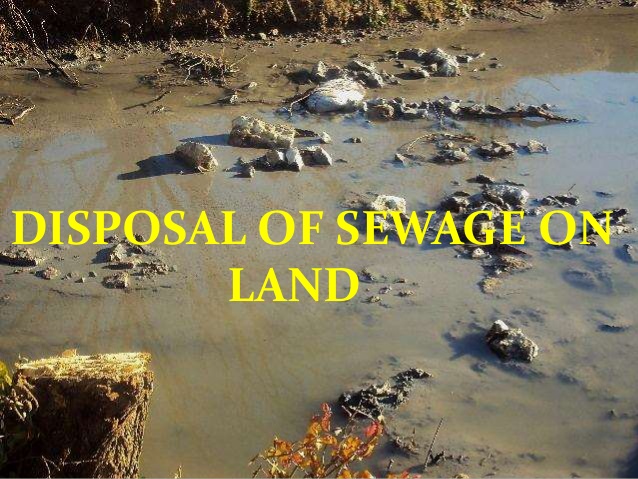
(3) Refuse Disposal:
Refuse disposal means doing away with refuse. The following methods are adopted.
a. Decomposable materials: these are the remains of plants and animals which are thrown into farm lands to decay and form compost.
b. Combustible materials: these materials include paper and textile materials. They are burnt in incinerators.

EVALUATION:
What are the human activities that affect environmental balance?
In what ways are refuse disposed?
What is sewage water?
ASSIGNMENT:
Name two waste materials that are produced in your home.
LESSON 31
TOPIC: REFUSE DISPOSAL (CONTINUED)
OBJECTIVE: At the end of the lesson, the students should be able to:
1. Define recycling.
2. Explain how glass materials are disposed.
3. Describe the effect of transportation on the environment
CONTENT:
c. Glass materials: these are collected, ground and used to make new glass containers.
d. Recycling: this means using again what has been used before. Bottles are used and returned e.g. soft drinks bottles. In this way the same bottles are washed after use, and are used over and over again. This is an example of recycling. It prevents the throwing away of glass bottles all over the environment.
e. Construction: every construction process involves a certain amount of destruction of plants on site clearing. Construction may soften or disturb the soil and often promotes erosion.
5 . Transportation: transportation affects the environment. Road transport requires roads. In order to construct roads, vegetation is cleared. Motor vehicles, trains, ships, aeroplanes produce carbon dioxide which pollutes the air.
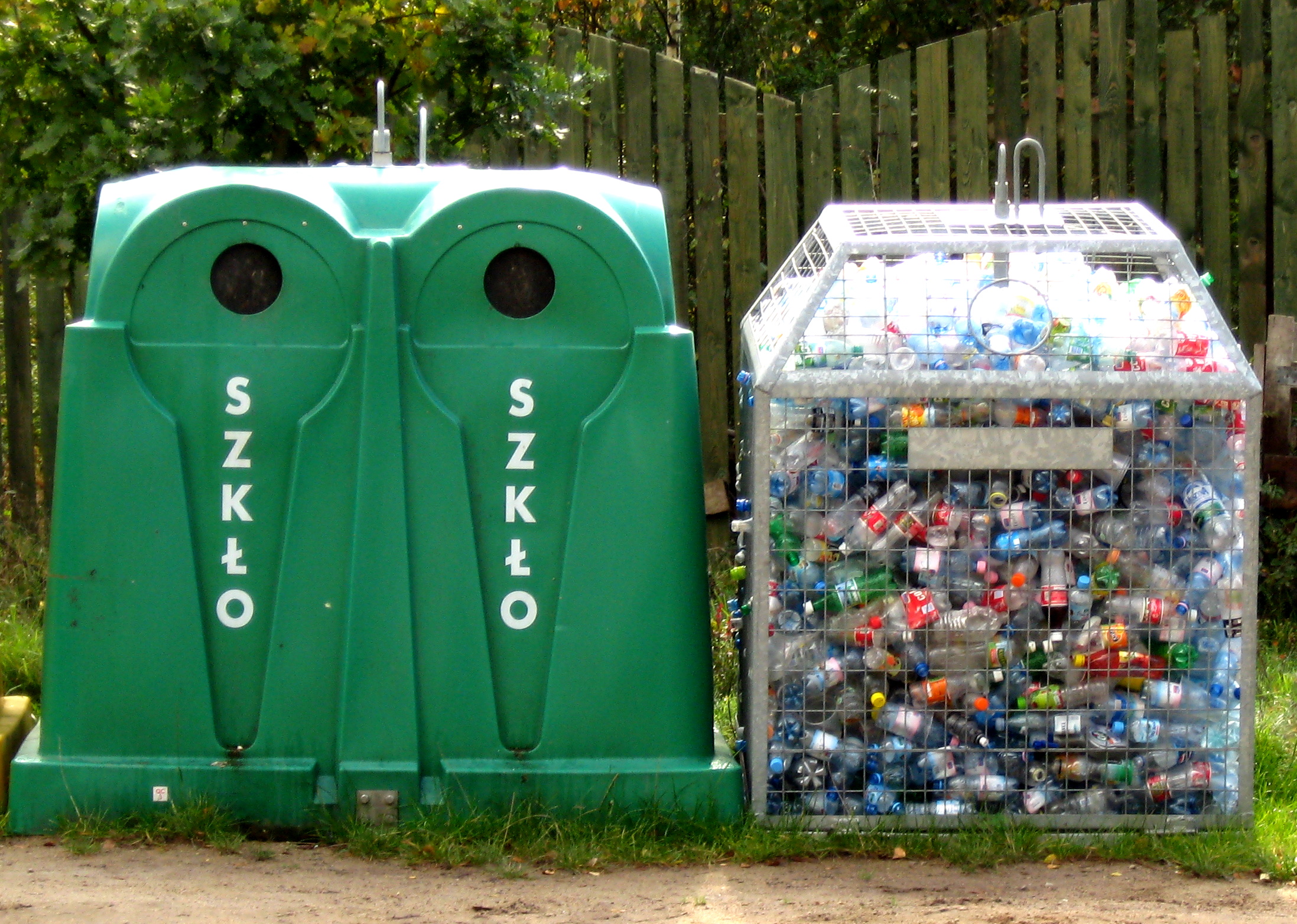
https://youtu.be/71uGLgLEJJs
EVALUATION:
What is recycling?
How are glass materials disposed?
What are the effects of transportation in the environment?
ASSIGNMENT:
Make a list of all the refuse collected and explain how each of them can be properly disposed.
LESSON 32
TOPIC: BIO-DEGRADABLE AND NON BIO-DEGRADABLE MATERIALS
OBJECTIVE: At the end of the lesson, the students should be able to:
1. Define biodegradable material.
2. Define non biodegradable material.
3. Give examples of both biodegradable and non bio-degradable materials.
CONTENT:
A biodegradable material such as vegetable, fruit and meat is one which can decay, and be broken down by micro organisms that cause decay.

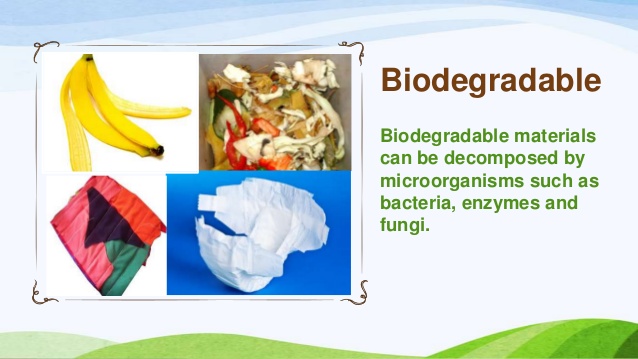
A non biodegradable material is one which cannot be broken down by micro organisms. Examples of non biodegradable materials are plastic, glass and steel.
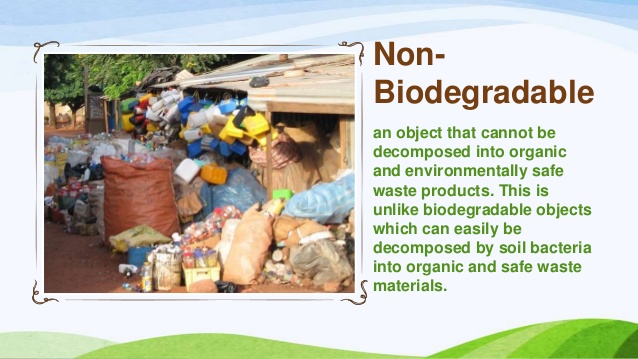
The decay of dead material is brought about by very minute living organisms such as bacteria and fungi. The process of decay involves the breakdown of complex substances to simple ones.
http://wiki.answers.com/Q/What_is_the_d ... degradable
EVALUATION:
What is a biodegradable material?
What is a non biodegradable material?
What are the examples of both biodegradable and non biodegradable materials?
ASSIGNMENT:
Copy and complete the table below:
Examples of biodegradable materials Examples of non biodegradable materials
LESSON 33
TOPIC: THE COMPOST
OBJECTIVE: At the end of the lesson, the students should be able to:
1. Define compost.
2. Give examples of materials that can be used to make compost.
CONTENT:
The compost is decayed plants and animal matter. It is used to manure farm crops. The importance of compost is that it makes soil that has lost its fertility, fertile again.
In a home, biodegradable refuse from the kitchen or elsewhere can be used to make compost, thereby putting this kind of refuse into good use.
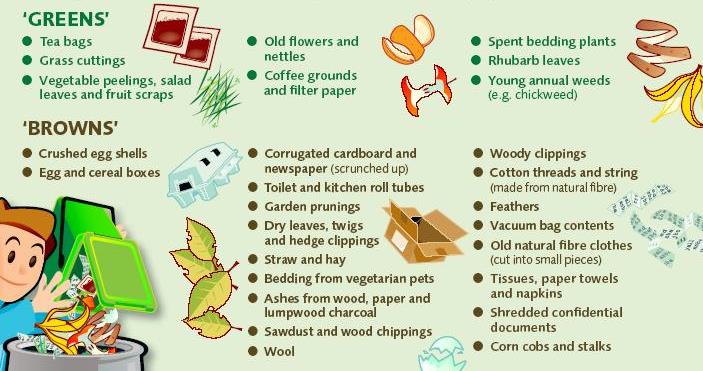
HOW TO MAKE COMPOST
Gather as much biodegradable matter as you can and place in a square marked A. After two weeks, transfer the material in square A into another square B and put fresh material in square A. After two weeks, repeat the process again and do it over in the next two weeks. The whole process of turning material from square A to B to C to D is called COMPOST MAKING.
https://youtu.be/2s5HdYLSFzg
EVALUATION:
What is compost?
What are the materials that can be used to make compost?
ASSIGNMENT:
Explain how proper refuse disposal promotes good health.
TOPIC: ENVIRONMENTAL CONSERVATION AND SAFETY (SANITATION)
CONTENT: Definition of conservation
Types of human activities
Effects of human activities on ecosystem.
Conservation is defined as the control exploitation, planned or judicious use of natural resources to ensure their continuous availability and to preserve the quality or original nature of the environment. It can also be defined as the preservation of natural resources from loss waste or exploitation.
TYPES OF HUMAN ACTIVITIES
Some human activities on the environment include:
i. Farming
ii. Construction of roads and houses
iii. Use of transportation
iv. Construction of industries
v. Disposal of refuse, sewage, industrial effluent and
vi. Industrialization
vii, Mining
One important way of improving our environment is by maintaining a high level of sanitation. Sanitation is the removal of waste of all kinds from the home and its immediate surroundings. These include refuse which means dry waste and sewage which is the liquid wastes.
Effects of human activities on the ecosystem

1. Human activities have diverse effects on the ecosystem.
2. Farming causes soil erosion. Many animals are forced to migrate from their natural environment and become extinct.
3. Construction of roads and houses results in the loss of plants and animal species.
4. During the construction of industries, forests are destroyed, animals are killed, and it affects and alters the plants and animals species of the ecosystem.
5. Disposal of refuse, sewage, industrial effluent and waste causes pollution.
EVALUATION
Explain the effects of road construction and farming on ecosystem.
List all the types of human activities.
List three human activities that affect the environment.
Assignment
State the effects of human activities on the environment.
Reading assignment
Read Stan pages 67-72.
LESSON 30
TOPIC: ENVIRONMENTAL CONSERVATION AND SAFETY 2 (SANITATION)
OBJECTIVE: At the end of the lesson, the students should be able to:
1. Mention the types of human activities that affect environmental balance.
2. Explain ways of disposing refuse.
3. Define sewage water.
CONTENT:
Types of human activities that affect environmental balance:
There is a balance in nature. Many human activities affect environmental balance.

Human activities are comprised of many things which can destroy as well as endanger the environment and nature surrounding us. They are: coal mining (fossil extraction), factories, vehicles etc. They can pollute our environment and can destroy the nature and the animals.
They can also improve things.
Create fertile land where none existed for instance.
Human activities that damage the environment:
Burning fossil fuel
cutting trees
polluting water
Driving Cars
For example, global warming is the result of us humans not being considerate enough to care about what happens to all that deadly gas we emit into the environment.
Some others are
Pollution
Mass Manufacture
Deforestation
Introduction of exotic species to new environments
Overfishing
Specific human activities and the way they affect environmental balance are:
(1) Farming:
Farming affects environmental balance because when vegetation is cleared from the surface of the soil before cultivation is done. Clearing of vegetation exposes the soil to soil erosion by rain water. Mechanized cultivation of the soil for crop planting promotes wind erosion of soil, and dust pollution of the atmosphere.
A part of fertilizer applied to farm is washed out by surface floods into streams and rivers, thereby pollution the streams and rivers.

(2) Sewage Disposal:
Sewage is waste water together with waste materials in the water. It includes waste water from the toilet, from the bathroom and from the kitchen.
In a modern home, a water closet (WC) toilet is provided. Waste water from the kitchen and bathroom are also channeled into soak away pits. A good sewage system helps us to remain healthy by preventing the spread of disease germs.

(3) Refuse Disposal:
Refuse disposal means doing away with refuse. The following methods are adopted.
a. Decomposable materials: these are the remains of plants and animals which are thrown into farm lands to decay and form compost.
b. Combustible materials: these materials include paper and textile materials. They are burnt in incinerators.

EVALUATION:
What are the human activities that affect environmental balance?
In what ways are refuse disposed?
What is sewage water?
ASSIGNMENT:
Name two waste materials that are produced in your home.
LESSON 31
TOPIC: REFUSE DISPOSAL (CONTINUED)
OBJECTIVE: At the end of the lesson, the students should be able to:
1. Define recycling.
2. Explain how glass materials are disposed.
3. Describe the effect of transportation on the environment
CONTENT:
c. Glass materials: these are collected, ground and used to make new glass containers.
d. Recycling: this means using again what has been used before. Bottles are used and returned e.g. soft drinks bottles. In this way the same bottles are washed after use, and are used over and over again. This is an example of recycling. It prevents the throwing away of glass bottles all over the environment.
e. Construction: every construction process involves a certain amount of destruction of plants on site clearing. Construction may soften or disturb the soil and often promotes erosion.
5 . Transportation: transportation affects the environment. Road transport requires roads. In order to construct roads, vegetation is cleared. Motor vehicles, trains, ships, aeroplanes produce carbon dioxide which pollutes the air.

https://youtu.be/71uGLgLEJJs
EVALUATION:
What is recycling?
How are glass materials disposed?
What are the effects of transportation in the environment?
ASSIGNMENT:
Make a list of all the refuse collected and explain how each of them can be properly disposed.
LESSON 32
TOPIC: BIO-DEGRADABLE AND NON BIO-DEGRADABLE MATERIALS
OBJECTIVE: At the end of the lesson, the students should be able to:
1. Define biodegradable material.
2. Define non biodegradable material.
3. Give examples of both biodegradable and non bio-degradable materials.
CONTENT:
A biodegradable material such as vegetable, fruit and meat is one which can decay, and be broken down by micro organisms that cause decay.


A non biodegradable material is one which cannot be broken down by micro organisms. Examples of non biodegradable materials are plastic, glass and steel.

The decay of dead material is brought about by very minute living organisms such as bacteria and fungi. The process of decay involves the breakdown of complex substances to simple ones.
http://wiki.answers.com/Q/What_is_the_d ... degradable
EVALUATION:
What is a biodegradable material?
What is a non biodegradable material?
What are the examples of both biodegradable and non biodegradable materials?
ASSIGNMENT:
Copy and complete the table below:
Examples of biodegradable materials Examples of non biodegradable materials
LESSON 33
TOPIC: THE COMPOST
OBJECTIVE: At the end of the lesson, the students should be able to:
1. Define compost.
2. Give examples of materials that can be used to make compost.
CONTENT:
The compost is decayed plants and animal matter. It is used to manure farm crops. The importance of compost is that it makes soil that has lost its fertility, fertile again.
In a home, biodegradable refuse from the kitchen or elsewhere can be used to make compost, thereby putting this kind of refuse into good use.

HOW TO MAKE COMPOST
Gather as much biodegradable matter as you can and place in a square marked A. After two weeks, transfer the material in square A into another square B and put fresh material in square A. After two weeks, repeat the process again and do it over in the next two weeks. The whole process of turning material from square A to B to C to D is called COMPOST MAKING.
https://youtu.be/2s5HdYLSFzg
EVALUATION:
What is compost?
What are the materials that can be used to make compost?
ASSIGNMENT:
Explain how proper refuse disposal promotes good health.
WEEK 8
LESSON 34
TOPIC 1
BIO DEGRADABLE AND NON BIODEGRADABLE MATERIALS
CONTENT:
The compost (Summary)
Benefits of environmental sanitation
The compost: Is the organic matter which are decomposed by the action of bacteria.
Biodegradable materials are the materials discharged through human activities from homes and industries into the environment and are capable of being decomposed by natural means such as the activities of micro-organisms while non-degradable materials are those which cannot be decomposed by natural means.
Examples of biodegradable materials are sewages like waste water, urines, feaces and others discharged from laundries, kitchen, toilet and bathrooms. Also examples of non-degradable materials are solid waste such as packaging materials, nylons, pure water nylon, bones, hairs, chemicals.
Effects of biodegradable and non-biodegradable materials
It causes high sanitation hazards
It creates bad color
It provides breeding grounds for insects and rodents that spread diseases
It hinders and harms the activities of beneficial micro-organisms.
It causes health hazards
Control of Biodegradable and Non-biodegradable materials in an environment
The way of controlling biodegradable and non-biodegradable materials are
i. Provision of dustbins with cover in strategic places
ii. Burning of refuse in incinerator
iii. Dumping them in isolated areas far from human habitation
iv. Burying refuse in a sanitary landfill
v. Creating or setting-up of enforcement sanitary personnel by the government To ensure commitment with sanitary rules
vi. Embark on enlightenment through radio and television programmes on adequate and proper refuse disposal
EVALUATION
(1). What are degradable materials
(2). Define compose
(3). List 5 effects of biodegradable and non-biodegradable materials on environmental sanitation
(4). List 5 ways of controlling biodegradable materials
(5). List the effects of non-degradable materials
ASSIGNMENT
Differentiate between sewage and refuse.
Mention ways of disposing refuse and sewage
READING ASSIGNMENT. Read Stan pages 67-79.
LESSON 35
TOPIC: BENEFITS OF ENVIRONMENTAL SANITATION
OBJECTIVE: At the end of the lesson, the students should be able to:
1. Mention the importance of a clean environment.
2. Outline the benefits of environmental sanitation.
CONTENT:
A clean environment promotes human health because it does not encourage the growth of disease causing organisms. Keeping the environment clean therefore keeps the human beings in that environment healthy.

The followings are benefits of environmental sanitation:
(1) The environment will be tidy and pleasurable.
(2) The cleared refuse from land will make the land available for other good purposes.
(3) The roads will be free of refuse thereby reducing road accidents.
(4) The gutters will be free of refuse, thereby allowing free flow of water.
EVALUATION:
What is the importance of a clean environment?
What are the benefits of environmental sanitation?
ASSIGNMENT:
List three human activities that negatively affect the environment.
LESSON 36
TOPIC: DISEASE VECTORS
OBJECTIVE: At the end of the lesson, the students should be able to:
1. Define disease.
2. Define disease vectors.
3. Mention the characteristics of a vector.
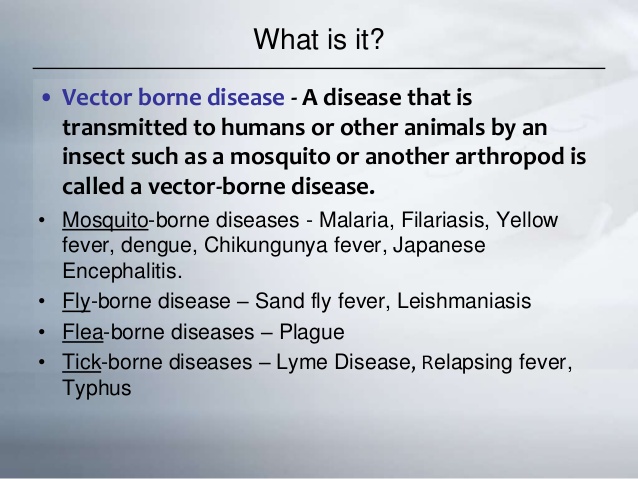
CONTENT:
Disease is the disruption of normal body functions, which may alter a person's normal work and social activities. Disease occurs when the germ (micro-organism), which causes the disease, enters the body and overcome the body - defense, causing illness or unhealthy condition of the body.
Disease vectors are animals which carry or pass germs from an infected person to a healthy person who may eventually have the disease or become ill.
Characteristics of a Vector
(1) A vector is a small animal, sometimes an insect.
(2) It passes germs from one person to another.
(3) The germs grow and develop inside the vector to a stage that they can infect another person, when introduced into the person's body.
(4) The vector is not made sick by the fact that it has the disease causing germs in its body.
http://www.youtube.com/watch?v=2KsOxqMwCzg
EVALUATION:
What is a disease?
What are disease vectors?
What are the characteristics of a vector?
ASSIGNMENT:
Draw the life cycle of the mosquito.
LESSON 37
TOPIC: TYPES OF DISEASE VECTORS
OBJECTIVE: At the end of the lesson, the students should be able to:
1. Mention the types of disease vectors.
2. Mention the diseases the disease vectors cause.
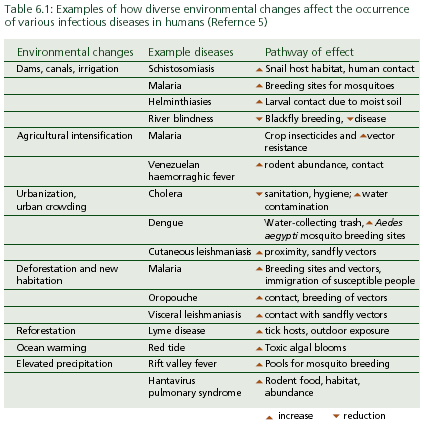
CONTENT:
DISEASE ..................VECTOR................................WHERE THEY ARE FOUND
Malaria ........Female anopheles mosquito...........The tropics and subtropics
River blindness........Black fly.................................Africa
Filariasis ...........Anopheles & Culex mosquitoes...The tropics & subtropics
Yellow fever........Aedes mosquito.........................The tropics and subtropics
Sleeping sickness
(trypanosomiasis).....Tsetse fly.............................The tropics
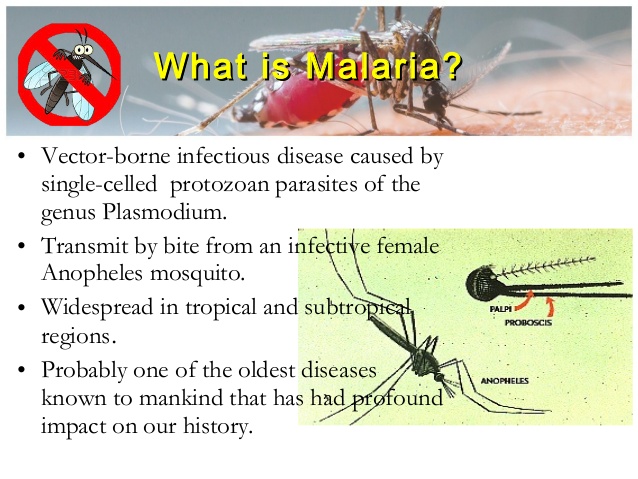
1. FEMALE ANOPHELES MOSQUITOES:
These are carriers of the malaria parasite called PLASMODIUM which causes malaria fever.
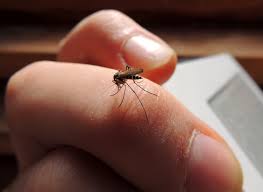

2. CULEX MOSQUITOES:
These are the carriers of filarial worm that causes elephantiasis.

3. AEDES MOSQUITOES:
These are the carriers of viruses that causes yellow fever.

4. TSETSE FLIES:
These transmit parasites that cause sleeping sickness in both human beings and cattle, sheep, goats and dogs.
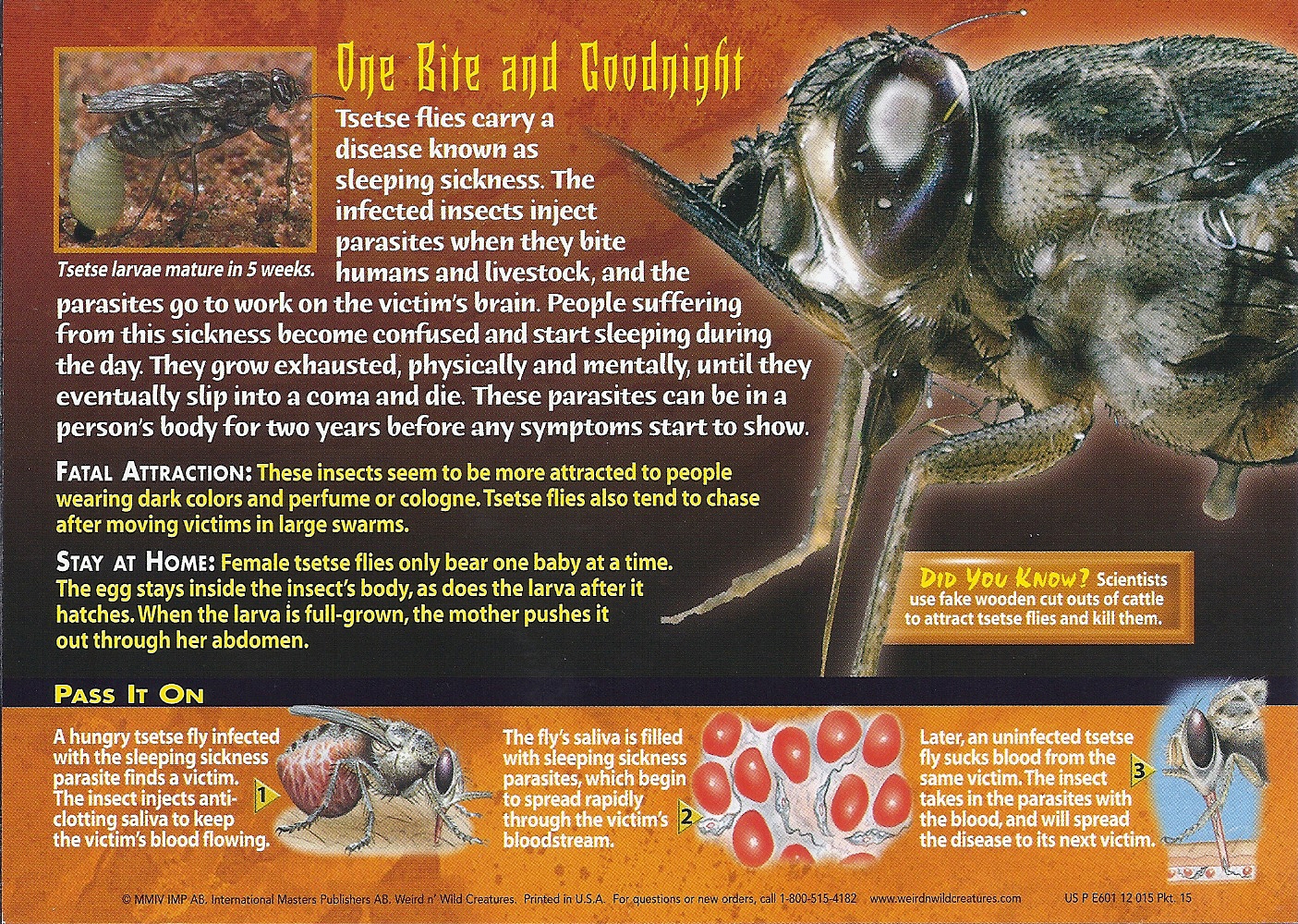
5. BLACK FLIES:
These transmit parasites that cause river blindness.
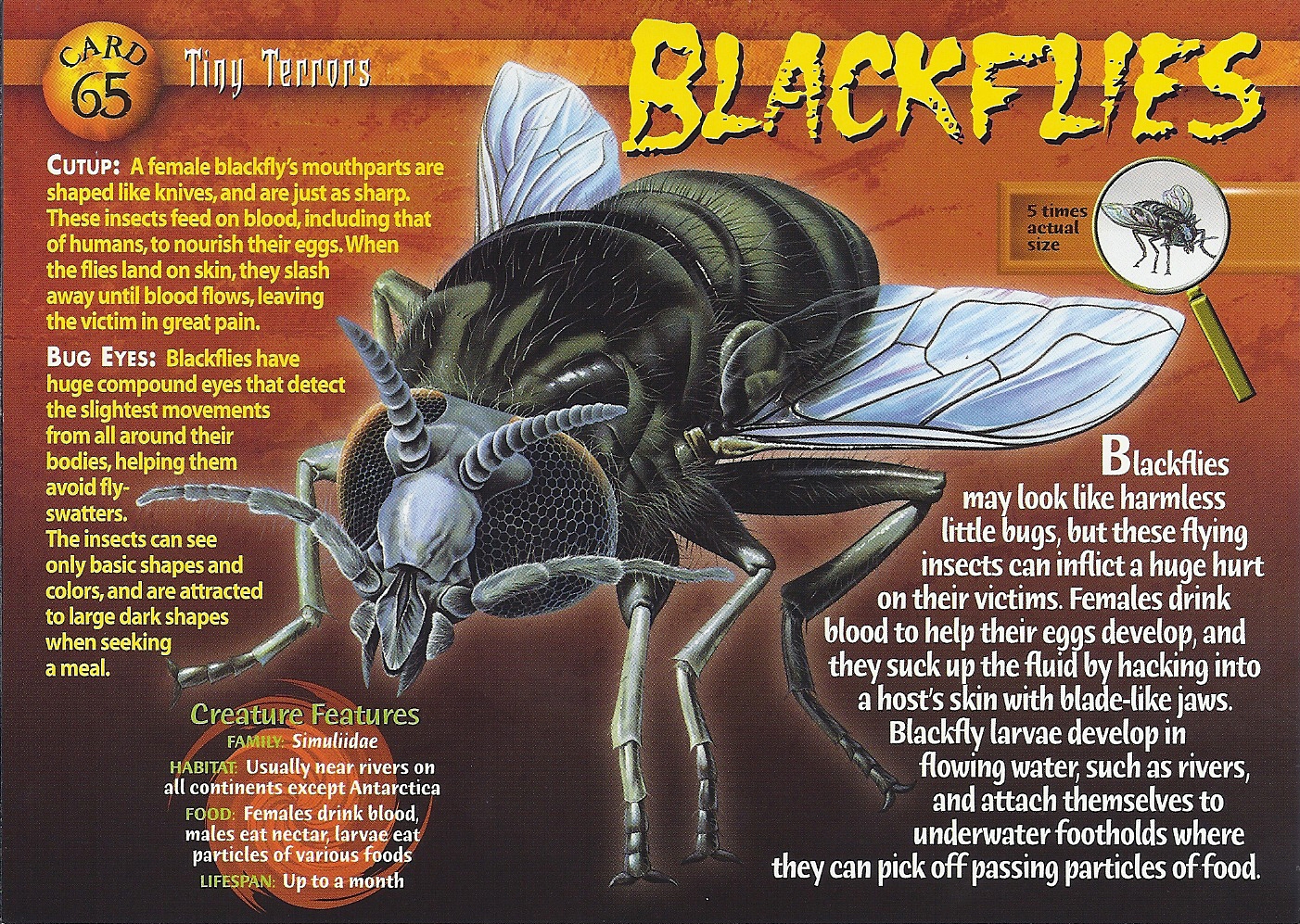
EVALUATION:
What are the topics of disease vectors?
What are the diseases the vectors cause?
ASSIGNMENT:
How can the spread of mosquito bee controlled in our community?
further studies
http://malaria.emedtv.com/malaria/malaria.html
practice test
http://www.syvum.com/cgi/online/oatm.cg ... toms.tdf?0
TOPIC 1
BIO DEGRADABLE AND NON BIODEGRADABLE MATERIALS
CONTENT:
The compost (Summary)
Benefits of environmental sanitation
The compost: Is the organic matter which are decomposed by the action of bacteria.
Biodegradable materials are the materials discharged through human activities from homes and industries into the environment and are capable of being decomposed by natural means such as the activities of micro-organisms while non-degradable materials are those which cannot be decomposed by natural means.
Examples of biodegradable materials are sewages like waste water, urines, feaces and others discharged from laundries, kitchen, toilet and bathrooms. Also examples of non-degradable materials are solid waste such as packaging materials, nylons, pure water nylon, bones, hairs, chemicals.
Effects of biodegradable and non-biodegradable materials
It causes high sanitation hazards
It creates bad color
It provides breeding grounds for insects and rodents that spread diseases
It hinders and harms the activities of beneficial micro-organisms.
It causes health hazards
Control of Biodegradable and Non-biodegradable materials in an environment
The way of controlling biodegradable and non-biodegradable materials are
i. Provision of dustbins with cover in strategic places
ii. Burning of refuse in incinerator
iii. Dumping them in isolated areas far from human habitation
iv. Burying refuse in a sanitary landfill
v. Creating or setting-up of enforcement sanitary personnel by the government To ensure commitment with sanitary rules
vi. Embark on enlightenment through radio and television programmes on adequate and proper refuse disposal
EVALUATION
(1). What are degradable materials
(2). Define compose
(3). List 5 effects of biodegradable and non-biodegradable materials on environmental sanitation
(4). List 5 ways of controlling biodegradable materials
(5). List the effects of non-degradable materials
ASSIGNMENT
Differentiate between sewage and refuse.
Mention ways of disposing refuse and sewage
READING ASSIGNMENT. Read Stan pages 67-79.
LESSON 35
TOPIC: BENEFITS OF ENVIRONMENTAL SANITATION
OBJECTIVE: At the end of the lesson, the students should be able to:
1. Mention the importance of a clean environment.
2. Outline the benefits of environmental sanitation.
CONTENT:
A clean environment promotes human health because it does not encourage the growth of disease causing organisms. Keeping the environment clean therefore keeps the human beings in that environment healthy.

The followings are benefits of environmental sanitation:
(1) The environment will be tidy and pleasurable.
(2) The cleared refuse from land will make the land available for other good purposes.
(3) The roads will be free of refuse thereby reducing road accidents.
(4) The gutters will be free of refuse, thereby allowing free flow of water.
EVALUATION:
What is the importance of a clean environment?
What are the benefits of environmental sanitation?
ASSIGNMENT:
List three human activities that negatively affect the environment.
LESSON 36
TOPIC: DISEASE VECTORS
OBJECTIVE: At the end of the lesson, the students should be able to:
1. Define disease.
2. Define disease vectors.
3. Mention the characteristics of a vector.

CONTENT:
Disease is the disruption of normal body functions, which may alter a person's normal work and social activities. Disease occurs when the germ (micro-organism), which causes the disease, enters the body and overcome the body - defense, causing illness or unhealthy condition of the body.
Disease vectors are animals which carry or pass germs from an infected person to a healthy person who may eventually have the disease or become ill.
Characteristics of a Vector
(1) A vector is a small animal, sometimes an insect.
(2) It passes germs from one person to another.
(3) The germs grow and develop inside the vector to a stage that they can infect another person, when introduced into the person's body.
(4) The vector is not made sick by the fact that it has the disease causing germs in its body.
http://www.youtube.com/watch?v=2KsOxqMwCzg
EVALUATION:
What is a disease?
What are disease vectors?
What are the characteristics of a vector?
ASSIGNMENT:
Draw the life cycle of the mosquito.
LESSON 37
TOPIC: TYPES OF DISEASE VECTORS
OBJECTIVE: At the end of the lesson, the students should be able to:
1. Mention the types of disease vectors.
2. Mention the diseases the disease vectors cause.

CONTENT:
DISEASE ..................VECTOR................................WHERE THEY ARE FOUND
Malaria ........Female anopheles mosquito...........The tropics and subtropics
River blindness........Black fly.................................Africa
Filariasis ...........Anopheles & Culex mosquitoes...The tropics & subtropics
Yellow fever........Aedes mosquito.........................The tropics and subtropics
Sleeping sickness
(trypanosomiasis).....Tsetse fly.............................The tropics

1. FEMALE ANOPHELES MOSQUITOES:
These are carriers of the malaria parasite called PLASMODIUM which causes malaria fever.


2. CULEX MOSQUITOES:
These are the carriers of filarial worm that causes elephantiasis.

3. AEDES MOSQUITOES:
These are the carriers of viruses that causes yellow fever.

4. TSETSE FLIES:
These transmit parasites that cause sleeping sickness in both human beings and cattle, sheep, goats and dogs.

5. BLACK FLIES:
These transmit parasites that cause river blindness.

EVALUATION:
What are the topics of disease vectors?
What are the diseases the vectors cause?
ASSIGNMENT:
How can the spread of mosquito bee controlled in our community?
further studies
http://malaria.emedtv.com/malaria/malaria.html
practice test
http://www.syvum.com/cgi/online/oatm.cg ... toms.tdf?0
WEEK 9
LESSON 38
TOPIC: DISEASE VECTORS
CONTENT
Types of disease vectors
A vector is an animal or insect which can carry micro-organism that cause disease from one animal to another. Examples of vectors are rats, ticks, fleas and other insect such as mosquitoes, flies and lice.
Disease is a state of ill health or a disruption of the normal functioning of the body. There are diseases that can be passed from person to person or from animal to man. These are called communicable (infectious) diseases caused by micro-organisms like bacteria, viruses and protozoan. Organisms that cause diseases are called pathogens. Diseases that are not passed on to other people are called non-communicable (non-infectious) diseases.
TYPES OF DISEASE VECTORS
Mosquitoes
Tsetse fly
Black fly
Aphids
House fly
Bedbug
LIFE CYCLE OF THE MOSQUITO
The mosquito is the carrier of the micro-organism which causes malaria. The micro-organism is a protozoan called plasmodium. It lives in the blood cells, passes waste matter into them and eventually destroys them. The malaria parasite is carried is carried by the female anopheles. When the mosquito bites a person it passes the parasite into the blood.
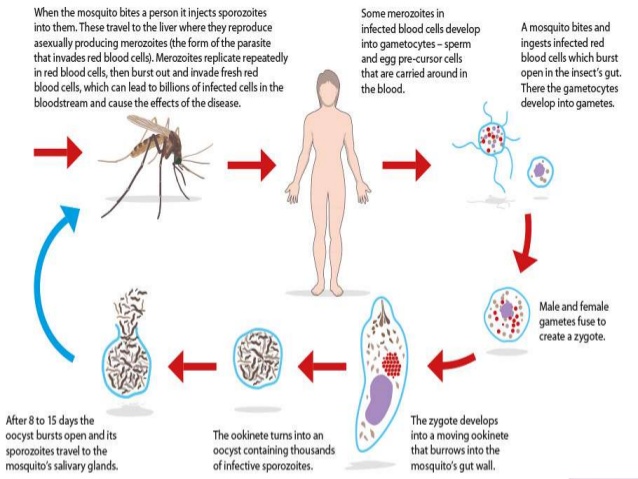
The stages in the life cycle of the mosquito: eggs-larva-pupa-adult
.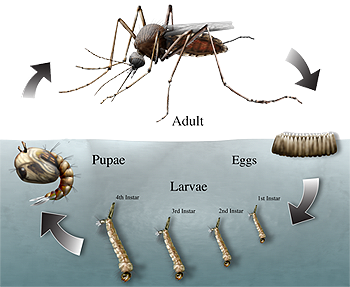
Evaluation
What is a vector?
Explain the life cycle of a mosquito.
LESSON 39
Sub –Topic: Other Vectors
Control measures : water drainage, insecticides, oil spreading/spraying.
Transmission of malaria, river blindness, and sleeping sickness.
HOUSE FLY
This is the common name for the most of familiar species of non-biting muscoid fly. It is found in the vicinity of human habitations throughout the world. It is often a carrier of such diseases as typhoid fever, cholera, dysentery, trachoria and anthrax. The adult fly transmits disease by contaminating food with disease organisms which it has picked up on its hairy legs or has ingested and then regurgitated.
LIFE CYCLE OF THE HOUSEFLY: The female lays an average of 150 white eggs in a mass. The female can live for about two months and can lay between 600 to 1000 eggs during its lifetime. The eggs hatch in about 12 hours into white, legless larvae called maggots which grow to 12.5mm in length. The maggots develop into pupa in five to six days. The pupa develops into a new adult in another four
to five days if the weather is warm or in a month or later if weather conditions are favourable.
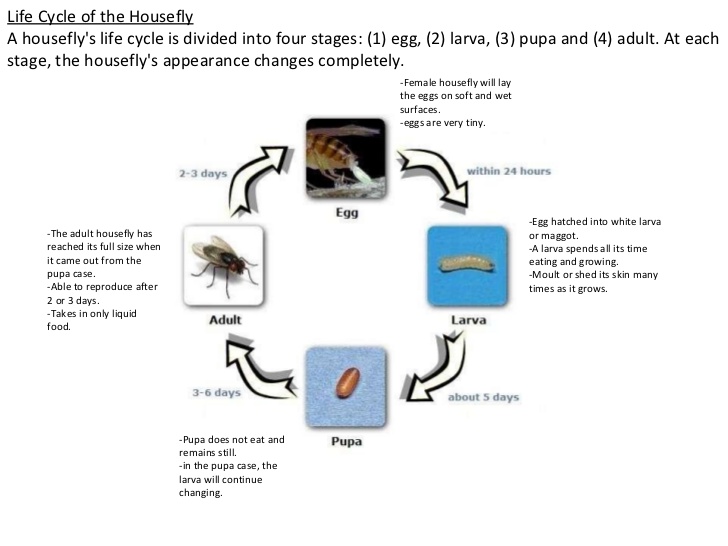
LIFE CYCLE OF TSETSE-FLY
Tsetse-fly carries the sleeping sickness parasite. The parasite is trypanosome. The tsetse-fly spread the disease to man and other animals like goats, sheep pigs, horses and donkeys, by biting them. The parasite is passed to the bitten animal through the saliva of the tsetse fly. The bitten animals begin to feel the effects of the parasite after one to three weeks. The human victim suffers fever, headache, and frequent sleeping; hence it is called sleeping sickness or nagana.
Tsetse flies breed in shady, damp places such as the vegetation by the river side. Some breed in open places like the grassland. One mating is sufficient for the tsetse fly to continue to produce new tsetse flies for the rest of her life time. The tsetse fly has a life span of between three weeks and five months. The eggs develops inside the fly and hatch into larvae which are released in a shady place.
The larva then developed into pupa and pupa to adult or imago.
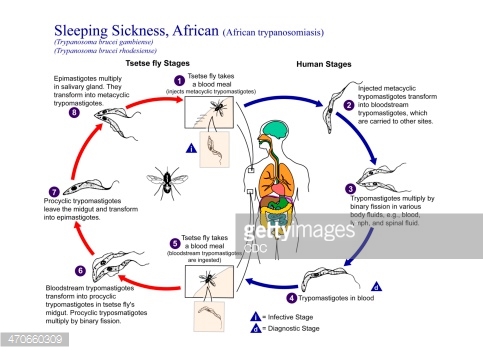
LESSON 40
TOPIC: LIFE CYCLE OF THE MOSQUITO
OBJECTIVES: At the end of the lesson, the students should be able to:
1. Mention the stages of mosquito life cycle.
2. Describe each stage of the life cycle.
CONTENT:
LIFE CYCLE OF ANOPHELES MOSQUITO
MOSQUITO: the female anopheles mosquito is an insect. The life cycle has four stages. It is therefore said to have a complete METAMORPHOSIS.

(1) Egg:
The adult female anopheles mosquito lays her eggs singly in stagnant water such as ponds, puddles, water collected in dirty gutters, cans etc. in two days it hatches into a larva.
(2) Larva:
The larva feeds on water plants and after 10 days changes into a pupa. The larva is long and lies just under the water surface.
(3) Pupa:
The pupa is comma shaped. It does not feed and at about seven days changes into the young adult or imago.
(4) Imago:
The imago is like the adult but small. The total time for metamorphosis is about 21 days but this varies with temperature. In hot weather, metamorphosis is faster than in cold weather.
EVALUATION:
What are the stages of mosquito life cycle?
What is involved in each stage of life cycle?
ASSIGNMENT:
Mention 3 ways of contracting disease.
http://www.enchantedlearning.com/subjec ... /mosquito/
further studies
Malaria is transmitted between people by female Anopheles mosquitoes, and more than 60 species have been incriminated in the transmission of infection (there are about 430 species of Anopheles, and about 3500 species of mosquitoes altogether).
Some species are more significant than others as vectors because of variations in susceptibility to the parasite or the propensity of the mosquito to bite humans and to enter houses when looking for a blood meal. Anopheles gambiae sensu lato is the vector of most significance in Africa.
Both male and female mosquitoes feed on nectar and damaged fruits. But only females feed on animal blood to provide proteins for their eggs. The adult mosquito survives for between one week and one month.
Females lay their eggs in batches of 70-100 on the surface of water at night. The type of water used for egg laying is indicative of the mosquito species and includes irrigation channels, a pool of water in a tree trunk, and sewage effluent. In tropical temperatures the eggs hatch after two to three days.
The larvae lie just below the surface of the water and feed on algae, and after 7-14 days turn into pupae during a five-minute process. The pupa is comma-shaped and is the least active stage of the Anopheles lifecycle. After two to four days the pupa metamorphoses into an adult mosquito. The adults emerge during late evening and are able to fly within minutes.
Mosquitoes usually mate during flight. The male is attracted to the female by the tone of her wing beat, and has antennae that act as sound receptors. Once mated, the female searches out a blood meal, following sensory cues such as host odour, carbon dioxide and convection currents. She then seeks out a resting place, which may be indoors or outdoors depending on the species.
When the blood meal has been digested, the ovaries develop and the mature eggs are laid at night.
practice test
http://quizlet.com/4878368/sphu-102-qui ... ash-cards/
LESSON 41
TOPIC: CONTROL MEASURES
OBJECTIVE: At the end of the lesson, the students should be able to:
1. Mention control measures.
2. Define water borne diseases.
3. Give examples of water borne diseases.
4. Describe how cholera is contracted.
CONTENT:
CONTROL MEASURES
These are ways or methods of preventing diseases from attacking us.
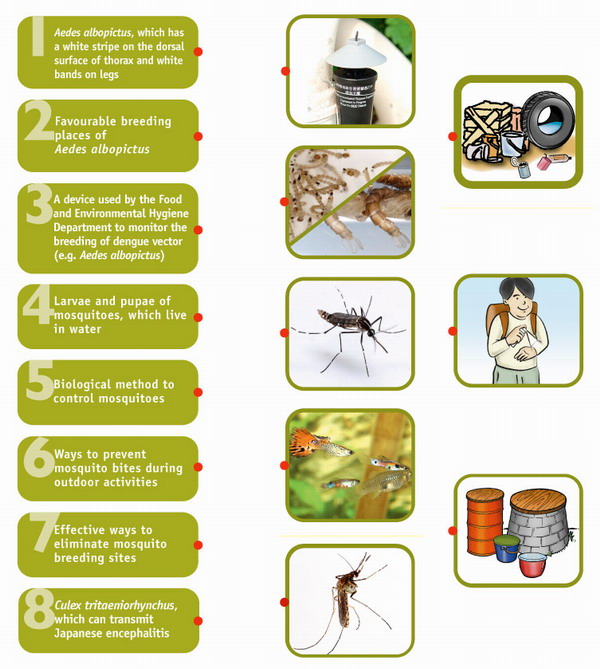
These control measures include:
(1) Water drainage: gutters should be cleared so that they do not contain stagnant water. Stagnant pools and ponds should also be dried. These will reduce the breeding sites of mosquito.
(2) Insecticides: spraying of insecticides also help in controlling the spread of malaria. Insecticides kill adult mosquitoes.
(3) Oil spreading/spraying: this should be done on stagnant waters, ponds and gutters. It destroys the breeding place of mosquitoes.
WATER BORNE DISEASES
These are the diseases that are spread through drinking of dirty water. Examples of water borne diseases are:
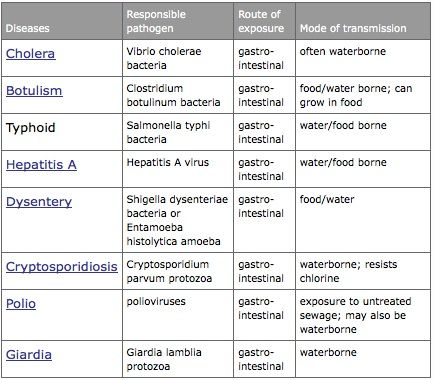
(1) CHOLERA:
Cholera is a serious disease of the human intestine. It is caused by bacteria known as Vibrio Cholerae. Symptoms of cholera are frequent stooling, dehydration, fever, weakness and stomach upset. If not treated promptly, cholera could lead to death.
Cholera is passed from one person to another by eaten infected food or drinking infected water. Cholera can be treated with antibiotic drugs, prescribed by a medical doctor.
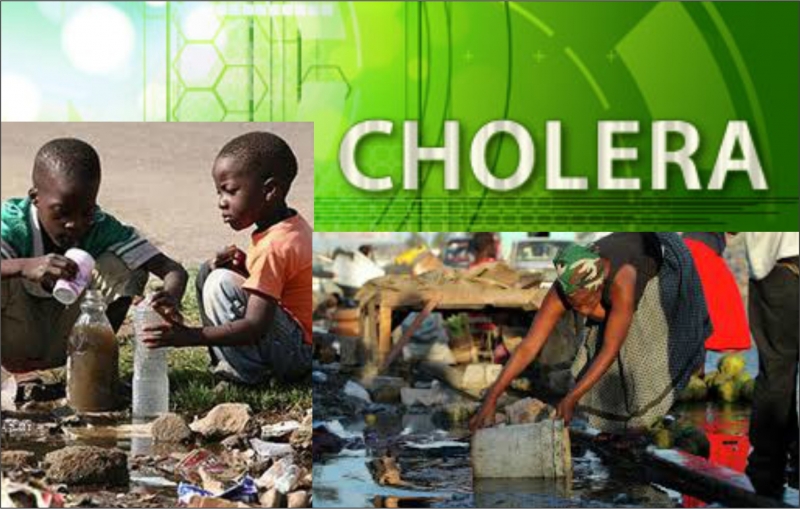
EVALUATION:
What are control measures?
What are water borne diseases?
What are the examples of water borne diseases?
How is cholera contracted?
ASSIGNMENT:
Explain the necessity of boiling water taken from untreated sources.
Further Studies
http://bodyandhealth.canada.com/channel ... n_id=70907
practice test
http://quiz.thefullwiki.org/Waterborne_diseases
http://www.funtrivia.com/playquiz/quiz72017841300.html
LESSON 42
TOPIC: WATER BORNE DISEASE (CONTD)
OBJECTIVE: At the end of the lesson, the students should be able to:
1. Enumerate the symptoms of diarrhoea.
2. Mention the treatment for diarrhoea and typhoid fever.
3. Mention the sources of clean water.
CONTENT:
2 . DIARRHOEA:
This is the disease that may be caused by overeating, virus infection of food or water, infection of food or water by bacteria, anxiety, stress, allergy to certain foods or food poisoning.
Symptoms of diarrhoea are cramps, abdominal pains, bloating of the belly, nausea, frequent stooling leading to dehydration. The disease spread through infection of food or water.

https://www.authorstream.com/Presentati ... -diseases/
3. TYPHOID FEVER:
This is a disease of the intestinal tract, occasionally of the blood stream too. It is caused by a bacteria. Symptoms include fever, headache, constipation and running stomach, enlarged liver and spleen. Doctors use specific antibiotics to treat cases of typhoid fever.

SOURCES OF CLEAN WATER
Sources of clean water include:
(1) Pipe borne water.
(2) Potable water (certified by an authorized government agency)
(3) Spring water
(4) Rain water after the early rains.
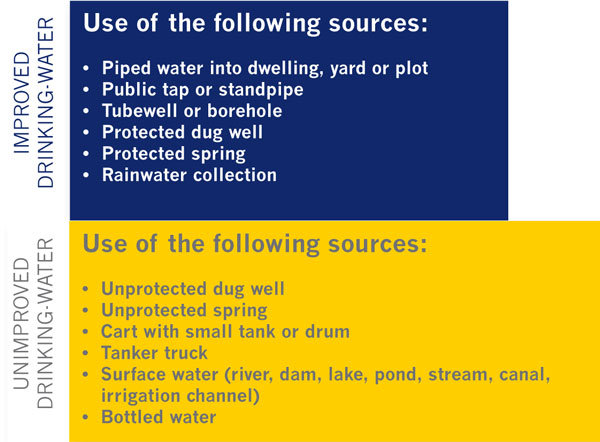
EVALUATION:
What are the symptoms of diarrhoea?
What are the treatment for diarrhoea and typhoid fever?
What are the sources of clean water?
ASSIGNMENT:
Students are to record their observations in their note books.
Students are to collect some pond water in a cup and mount a drop of it on a microscope slide which is to be examined in the laboratoratory.
Further Studies
https://www.medicinenet.com/typhoid_fever/article.htm
practice test
http://www.proprofs.com/quiz-school/qui ... &quesnum=1
http://www.funtrivia.com/trivia-quiz/Sc ... 85737.html
http://www.funtrivia.com/playquiz/quiz857379d3240.html
TOPIC: DISEASE VECTORS
CONTENT
Types of disease vectors
A vector is an animal or insect which can carry micro-organism that cause disease from one animal to another. Examples of vectors are rats, ticks, fleas and other insect such as mosquitoes, flies and lice.
Disease is a state of ill health or a disruption of the normal functioning of the body. There are diseases that can be passed from person to person or from animal to man. These are called communicable (infectious) diseases caused by micro-organisms like bacteria, viruses and protozoan. Organisms that cause diseases are called pathogens. Diseases that are not passed on to other people are called non-communicable (non-infectious) diseases.
TYPES OF DISEASE VECTORS
Mosquitoes
Tsetse fly
Black fly
Aphids
House fly
Bedbug
LIFE CYCLE OF THE MOSQUITO
The mosquito is the carrier of the micro-organism which causes malaria. The micro-organism is a protozoan called plasmodium. It lives in the blood cells, passes waste matter into them and eventually destroys them. The malaria parasite is carried is carried by the female anopheles. When the mosquito bites a person it passes the parasite into the blood.

The stages in the life cycle of the mosquito: eggs-larva-pupa-adult
.

Evaluation
What is a vector?
Explain the life cycle of a mosquito.
LESSON 39
Sub –Topic: Other Vectors
Control measures : water drainage, insecticides, oil spreading/spraying.
Transmission of malaria, river blindness, and sleeping sickness.
HOUSE FLY
This is the common name for the most of familiar species of non-biting muscoid fly. It is found in the vicinity of human habitations throughout the world. It is often a carrier of such diseases as typhoid fever, cholera, dysentery, trachoria and anthrax. The adult fly transmits disease by contaminating food with disease organisms which it has picked up on its hairy legs or has ingested and then regurgitated.
LIFE CYCLE OF THE HOUSEFLY: The female lays an average of 150 white eggs in a mass. The female can live for about two months and can lay between 600 to 1000 eggs during its lifetime. The eggs hatch in about 12 hours into white, legless larvae called maggots which grow to 12.5mm in length. The maggots develop into pupa in five to six days. The pupa develops into a new adult in another four
to five days if the weather is warm or in a month or later if weather conditions are favourable.

LIFE CYCLE OF TSETSE-FLY
Tsetse-fly carries the sleeping sickness parasite. The parasite is trypanosome. The tsetse-fly spread the disease to man and other animals like goats, sheep pigs, horses and donkeys, by biting them. The parasite is passed to the bitten animal through the saliva of the tsetse fly. The bitten animals begin to feel the effects of the parasite after one to three weeks. The human victim suffers fever, headache, and frequent sleeping; hence it is called sleeping sickness or nagana.
Tsetse flies breed in shady, damp places such as the vegetation by the river side. Some breed in open places like the grassland. One mating is sufficient for the tsetse fly to continue to produce new tsetse flies for the rest of her life time. The tsetse fly has a life span of between three weeks and five months. The eggs develops inside the fly and hatch into larvae which are released in a shady place.
The larva then developed into pupa and pupa to adult or imago.

LESSON 40
TOPIC: LIFE CYCLE OF THE MOSQUITO
OBJECTIVES: At the end of the lesson, the students should be able to:
1. Mention the stages of mosquito life cycle.
2. Describe each stage of the life cycle.
CONTENT:
LIFE CYCLE OF ANOPHELES MOSQUITO
MOSQUITO: the female anopheles mosquito is an insect. The life cycle has four stages. It is therefore said to have a complete METAMORPHOSIS.

(1) Egg:
The adult female anopheles mosquito lays her eggs singly in stagnant water such as ponds, puddles, water collected in dirty gutters, cans etc. in two days it hatches into a larva.
(2) Larva:
The larva feeds on water plants and after 10 days changes into a pupa. The larva is long and lies just under the water surface.
(3) Pupa:
The pupa is comma shaped. It does not feed and at about seven days changes into the young adult or imago.
(4) Imago:
The imago is like the adult but small. The total time for metamorphosis is about 21 days but this varies with temperature. In hot weather, metamorphosis is faster than in cold weather.
EVALUATION:
What are the stages of mosquito life cycle?
What is involved in each stage of life cycle?
ASSIGNMENT:
Mention 3 ways of contracting disease.
http://www.enchantedlearning.com/subjec ... /mosquito/
further studies
Malaria is transmitted between people by female Anopheles mosquitoes, and more than 60 species have been incriminated in the transmission of infection (there are about 430 species of Anopheles, and about 3500 species of mosquitoes altogether).
Some species are more significant than others as vectors because of variations in susceptibility to the parasite or the propensity of the mosquito to bite humans and to enter houses when looking for a blood meal. Anopheles gambiae sensu lato is the vector of most significance in Africa.
Both male and female mosquitoes feed on nectar and damaged fruits. But only females feed on animal blood to provide proteins for their eggs. The adult mosquito survives for between one week and one month.
Females lay their eggs in batches of 70-100 on the surface of water at night. The type of water used for egg laying is indicative of the mosquito species and includes irrigation channels, a pool of water in a tree trunk, and sewage effluent. In tropical temperatures the eggs hatch after two to three days.
The larvae lie just below the surface of the water and feed on algae, and after 7-14 days turn into pupae during a five-minute process. The pupa is comma-shaped and is the least active stage of the Anopheles lifecycle. After two to four days the pupa metamorphoses into an adult mosquito. The adults emerge during late evening and are able to fly within minutes.
Mosquitoes usually mate during flight. The male is attracted to the female by the tone of her wing beat, and has antennae that act as sound receptors. Once mated, the female searches out a blood meal, following sensory cues such as host odour, carbon dioxide and convection currents. She then seeks out a resting place, which may be indoors or outdoors depending on the species.
When the blood meal has been digested, the ovaries develop and the mature eggs are laid at night.
practice test
http://quizlet.com/4878368/sphu-102-qui ... ash-cards/
LESSON 41
TOPIC: CONTROL MEASURES
OBJECTIVE: At the end of the lesson, the students should be able to:
1. Mention control measures.
2. Define water borne diseases.
3. Give examples of water borne diseases.
4. Describe how cholera is contracted.
CONTENT:
CONTROL MEASURES
These are ways or methods of preventing diseases from attacking us.

These control measures include:
(1) Water drainage: gutters should be cleared so that they do not contain stagnant water. Stagnant pools and ponds should also be dried. These will reduce the breeding sites of mosquito.
(2) Insecticides: spraying of insecticides also help in controlling the spread of malaria. Insecticides kill adult mosquitoes.
(3) Oil spreading/spraying: this should be done on stagnant waters, ponds and gutters. It destroys the breeding place of mosquitoes.
WATER BORNE DISEASES
These are the diseases that are spread through drinking of dirty water. Examples of water borne diseases are:

(1) CHOLERA:
Cholera is a serious disease of the human intestine. It is caused by bacteria known as Vibrio Cholerae. Symptoms of cholera are frequent stooling, dehydration, fever, weakness and stomach upset. If not treated promptly, cholera could lead to death.
Cholera is passed from one person to another by eaten infected food or drinking infected water. Cholera can be treated with antibiotic drugs, prescribed by a medical doctor.

EVALUATION:
What are control measures?
What are water borne diseases?
What are the examples of water borne diseases?
How is cholera contracted?
ASSIGNMENT:
Explain the necessity of boiling water taken from untreated sources.
Further Studies
http://bodyandhealth.canada.com/channel ... n_id=70907
practice test
http://quiz.thefullwiki.org/Waterborne_diseases
http://www.funtrivia.com/playquiz/quiz72017841300.html
LESSON 42
TOPIC: WATER BORNE DISEASE (CONTD)
OBJECTIVE: At the end of the lesson, the students should be able to:
1. Enumerate the symptoms of diarrhoea.
2. Mention the treatment for diarrhoea and typhoid fever.
3. Mention the sources of clean water.
CONTENT:
2 . DIARRHOEA:
This is the disease that may be caused by overeating, virus infection of food or water, infection of food or water by bacteria, anxiety, stress, allergy to certain foods or food poisoning.
Symptoms of diarrhoea are cramps, abdominal pains, bloating of the belly, nausea, frequent stooling leading to dehydration. The disease spread through infection of food or water.
https://www.authorstream.com/Presentati ... -diseases/
3. TYPHOID FEVER:
This is a disease of the intestinal tract, occasionally of the blood stream too. It is caused by a bacteria. Symptoms include fever, headache, constipation and running stomach, enlarged liver and spleen. Doctors use specific antibiotics to treat cases of typhoid fever.

SOURCES OF CLEAN WATER
Sources of clean water include:
(1) Pipe borne water.
(2) Potable water (certified by an authorized government agency)
(3) Spring water
(4) Rain water after the early rains.

EVALUATION:
What are the symptoms of diarrhoea?
What are the treatment for diarrhoea and typhoid fever?
What are the sources of clean water?
ASSIGNMENT:
Students are to record their observations in their note books.
Students are to collect some pond water in a cup and mount a drop of it on a microscope slide which is to be examined in the laboratoratory.
Further Studies
https://www.medicinenet.com/typhoid_fever/article.htm
practice test
http://www.proprofs.com/quiz-school/qui ... &quesnum=1
http://www.funtrivia.com/trivia-quiz/Sc ... 85737.html
http://www.funtrivia.com/playquiz/quiz857379d3240.html